In this guide, you’ll learn how to create a content marketing funnel that consistently drives traffic, leads and sales. With no need for paid advertising.
To create this guide, I studied how dozens of successful businesses use content marketing.
Then I combined those insights with industry best practices and my own agency-side observations.
The result is the following step-by-step framework.
Read on.
Contents:
How Content Marketing Funnels Work
Social Media Content Marketing Funnel Example
SEO Content Marketing Funnel Example and Guide
Step 1: Do Intent-Based Keyword Research
Step 2: Evaluate Your Existing Content
Step 3: Outline Your Content Marketing Funnel
Step 4: Create Your Top-of-Funnel Content (Awareness/Attention)
Step 5: Create Middle-of-Funnel Content (Interest)
Step 6: Create Bottom-of-Funnel Content (Desire and Action)
Step 7: Strengthen Your Content Marketing Funnel to Reach “Effective Frequency”
Step 8: Measure and Optimize Your Marketing Funnel’s Performance
How Content Marketing Funnels Work
A content marketing funnel takes complete strangers and turns them into users, fans and customers.
It does this through AIDA, a four-stage process that describes the buyer’s journey:
Awareness, Interest, Desire, and Action.
At each step, the most engaged people continue while the less interested ones drop off.
So you can visualize the stages of AIDA as a funnel:
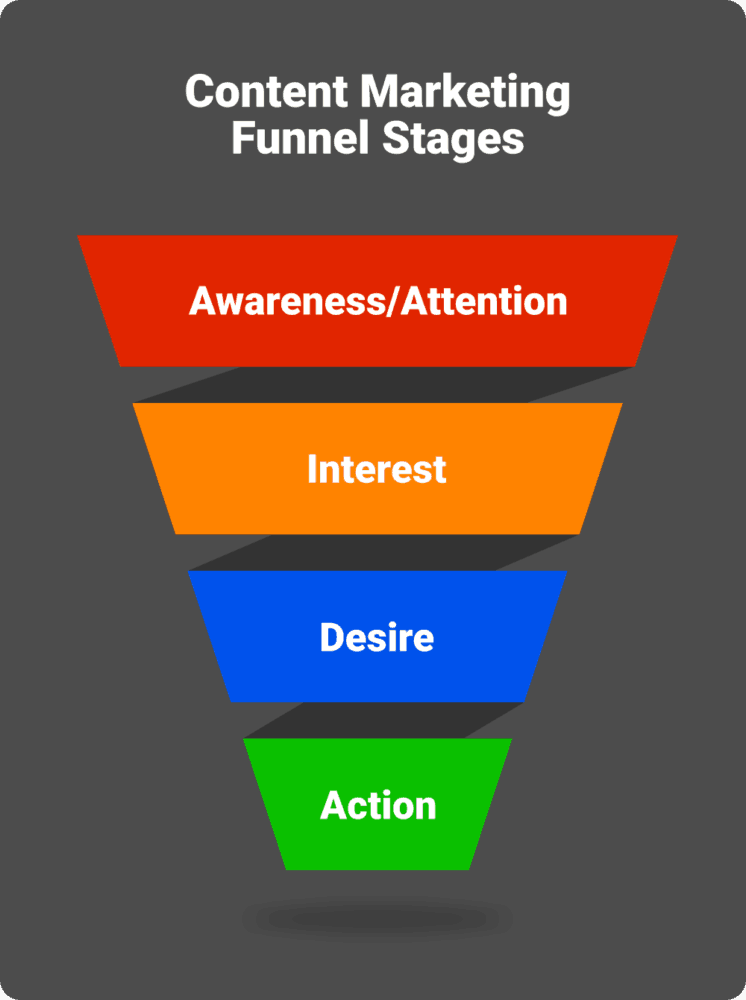
The top of your content marketing funnel is the Awareness stage: getting your target customers to become aware of you.
In a traditional advertising-based sales funnel, Awareness would include the broadest advertising methods like TV commercials and billboards.
In a content marketing funnel, the Awareness stage consists of top-of-funnel content. Where the goal is to get a lot of eyeballs — typically without much focus on what you’re actually selling. (Though it’s still important to attract relevant people. More on that later.)
The next stage is Interest: the middle of your content funnel.
This is where you build more trust with your audience and begin warming them up to what it is you are selling…
Whether by highlighting their problem, your solution, or both.
Desire and Action make up the bottom of your funnel.
These stages are where you’ll convince people to actually buy your product or service.
In this guide, I’ll show you how to build a content marketing funnel by creating a piece of content for each stage.
Each stage will bring people closer to a purchase…
Until your content finally makes the sale.
Now, let’s look at an example of an effective content marketing funnel that uses social media for the top of the funnel.
Then we’ll look at a step-by-step method for creating an SEO-based funnel.
Social Media Content Marketing Funnel Example
Roberto Robles runs an SEO agency as well as the SEO tool KatLinks.
A while back, he posted this simple tweet offering personalized SEO suggestions for free:

230 people replied.
Then Roberto went through and responded to each person with a short, personalized screenshare video. Like this one.
Here’s the magic part:
In those videos, Roberto used his own SEO tool to provide the tip. For example, by using it to do some basic keyword research.

Finally, Roberto embedded each video on a landing page on his site.
And underneath the video, he added links to both his SEO tool and his SEO agency.

With this strategy, Roberto found 230 founders and marketers who needed SEO help. And he essentially got them to watch a sales pitch for his SEO tool and agency services.
All with $0 in ad spend.
That’s just one example of a super basic content marketing funnel.
Of course, that funnel requires ongoing work to shoot each video. A high-priced agency can afford a hands-on approach like that, but many businesses can’t.
Let’s say you’re selling a cooking course instead.
In that case, you’d want to automate your content marketing sales funnel.
And you’d probably want to use a more visual social network at the top of your funnel. Like Instagram.
Your funnel could look like this:
Awareness/Attention: Instagram Stories with cooking tips, each with a “swipe up” link to access the recipe.
Interest: Recipe landing page with an email subscription form.
Desire and Action: 5-part email sequence that covers different healthy cooking tips and shows why they’re important (Desire). And then sells a cooking course to subscribers (Action).
See how each piece of content leads to the next one?
That’s what you want.
You can use the outline above as a template. And mix and match with your own pieces of content.
SEO Content Marketing Funnel Example and Guide
Now I’ll guide you through a more in-depth example and process. This example relies more on organic search traffic, but keep reading even if SEO isn’t a big part of your content marketing strategy.
Because with a few small tweaks, the following process will also work with non-SEO channels like paid advertising, social media and email marketing. Just think of the keywords as “topics” as you follow allow.
Step 1: Do Intent-Based Keyword Research
Part of what makes content marketing so powerful is the organic search traffic it can generate.
But your content can get lots of traffic without bringing in a single customer, if it doesn’t fit the intent of what people are searching for.
In other words, what the person making the search actually wants.
Do they want to buy?
Are they comparison-shopping?
Or are they just looking for some introductory information?
Different types of keywords match up with different intentions…
Which will match up with different parts of your content marketing funnel.
In fact, intent-based content should be the backbone of your content marketing funnel even if you don’t care about SEO.
But how can you find good keywords or topics and figure out the intent behind them?
I’ll show you a simple 3-step process to follow.
But first, let’s look at some quick examples of keywords that would fit into each level of the funnel.
Top-of-funnel keywords:
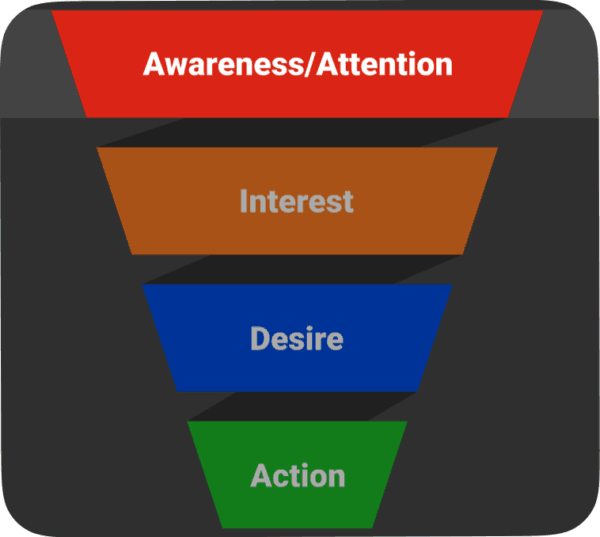
People searching with top-of-funnel keywords are usually looking for general information around a topic.
Which means they’re unlikely to make a purchase right away.
But these keywords tend to get a LOT of searches.
Examples of top-of-funnel keywords:
- “How long is a marathon”
- “Productivity tips”
- “How to start a blog”
You can see how those keywords would be relevant to businesses like shoe brands, productivity app companies, and WordPress hosting services.
But the people searching for them probably aren’t ready to buy anything yet.
Middle-of-funnel keywords tend to be more focused on a specific problem, solution, opportunity or activity.
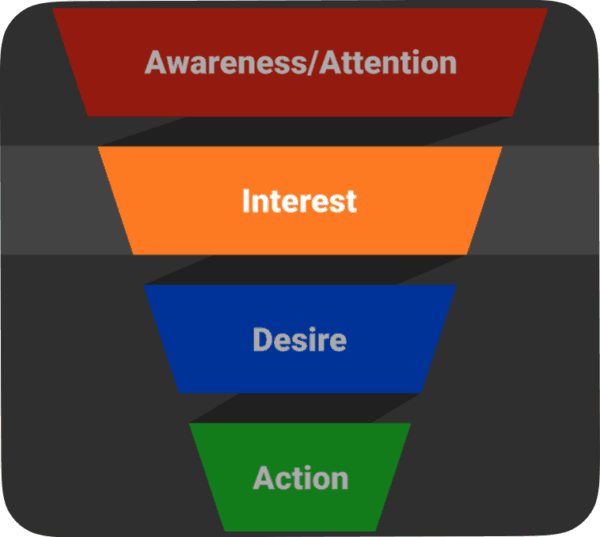
Examples of middle-of-funnel keywords:
- “How to train for a marathon”
- “Productivity apps”
- “Best blogging platforms”
These keywords represent questions people have as they get a little further along in the buyer’s journey.
They may still not be ready to pull out their wallets, but they’re researching things more deeply and with more intention.
Bottom-of-funnel keywords show purchase intent or consideration around a specific product or service.

But these keywords also have the least search volume.
That’s because a lot more people Google information about marathons than actually buy shoes to run them.
Examples of bottom-of-funnel keywords:
- “Where to buy running shoes for flat feet” or “Brooks Adrenaline GTS 19”
- “Asana vs Trello” or “Trello free trial”
- “WordPress hosting cost” or “Kinsta pricing”
Strung together, you can see how these different types of keywords can form a full buyer’s journey from Awareness to Interest, Desire and Action:
“How long is a marathon” ➡ “How to train for a marathon” ➡ “Where to buy running shoes for flat feet” ➡ “Brooks Adrenaline GTS 19”
“Productivity tips” ➡ “Productivity apps” ➡ “Asana vs Trello” ➡ “Trello free trial”
“How to start a blog” ➡ “Blogging platforms” ➡ “WordPress hosting cost” ➡ “Kinsta pricing”
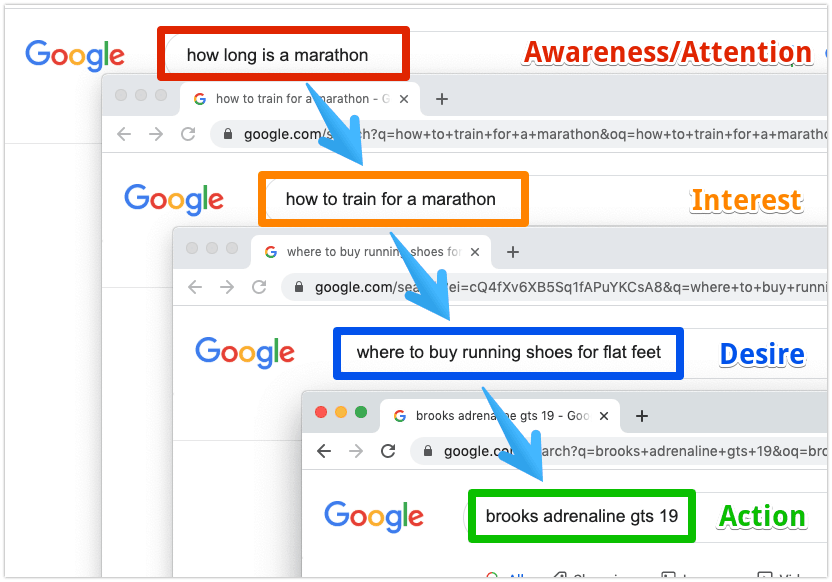
You can build a content marketing funnel by developing content for each of those keywords.
Here are 3 steps to find keywords to target and figure out the intent behind them.
(Note: if you have access to a paid tool like Ahrefs, Semrush or Mangools, you can also use that instead. Most paid SEO tools have similar functionality to the free option I’ll walk you through below.)
#1: Use Google Keyword Planner.
Google Keyword Planner is technically a tool for businesses who advertise on Google (via Google Ads)…
But you don’t have to spend a penny to use it.
And because it’s filled with data that comes straight from Google itself, Google Keyword Planner is one of the most widely-used keyword research tools out there.
I’m going to show you how to use it to:
- Find new keyword ideas
- See how many times each keyword gets searched for each month, and
- Understand the intent behind the keywords, based on how much advertisers are actually paying to advertise on them.
Start by going to to ads.google.com/home/tools/keyword-planner/ and clicking on the “Go to Keyword Planner” button.

Next, you’ll be prompted to either log in to your Google Ads account or create one for free if you don’t already have one.
But you don’t have to run any ads to use the tool; you just need an account.
(Side note: if you get the “What’s your main advertising goal?” question, you can get around it by clicking the “Experienced with Google Ads?” link at the bottom, then clicking “Create an account without a campaign.”)
Once you’re inside Google Keyword Planner, choose the option to “Discover new keywords.”

Next, type in some phrases related to your industry.
For example:
- The type of product or service you sell (e.g. “___ software”)
- Common goals, problems or questions your customers have (e.g. “how to ___”)
- Brand names of your largest competitors
You can enter more than one phrase at a time by separating them with commas.
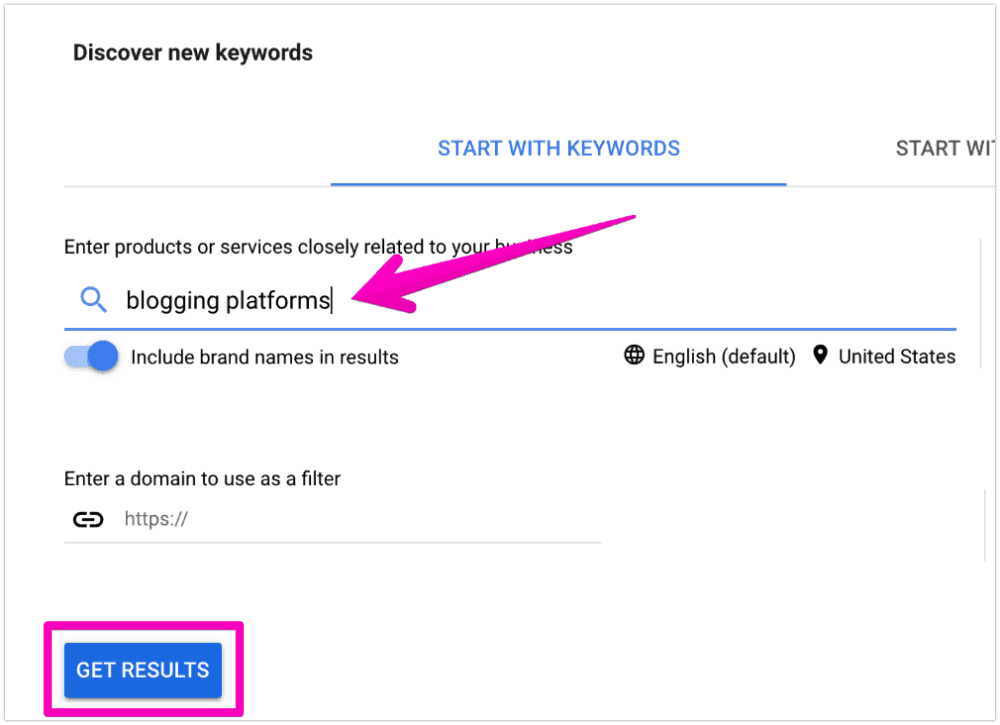
Then hit the “Get Results” button.
Alternatively, you can have Google pull keyword ideas from your competitors by choosing the “start with a website” option and entering a competitor’s URL:

Either way, Keyword Planner will spit out a list of keyword ideas and detailed information about each of them.
The two most important factors to look at are:
- Average number of monthly searches
- Average CPC (cost per click)
The average number of monthly searches shows the traffic potential of each keyword:
If you rank in the top 5 organic results for a given keyword, between 9% and 32% of its monthly search volume will typically end up clicking through to your site.
The average CPC is useful for determining how valuable a keyword is, and where it might fit in your content marketing funnel.
Depending on the niche and keyword, businesses spend anywhere from pennies to as much as $58+ for a single ad click on Google.
The more advertisers are willing to spend per click on a keyword, the more profitable that keyword must be.
… And the closer to the bottom of the marketing funnel it is.
However, Google no longer provides a single “average CPC” number.
Instead, you’ll see two numbers: the “low range” top of page bid and the “high range” top of page bid.
Those numbers tell you the least and most that advertisers are paying to show up in the ads at the top of a page of Google search results.
In the screenshot below, you can see that advertisers are paying between $0.60 and $10.02 per click for the keyword “how to start a blog,” vs $3.32 – $18.78 per click for “blogging platforms.”
Since the “blogging platforms” keyword is more expensive to bid on, it’s probably more profitable — and therefore closer to the bottom of the marketing funnel.
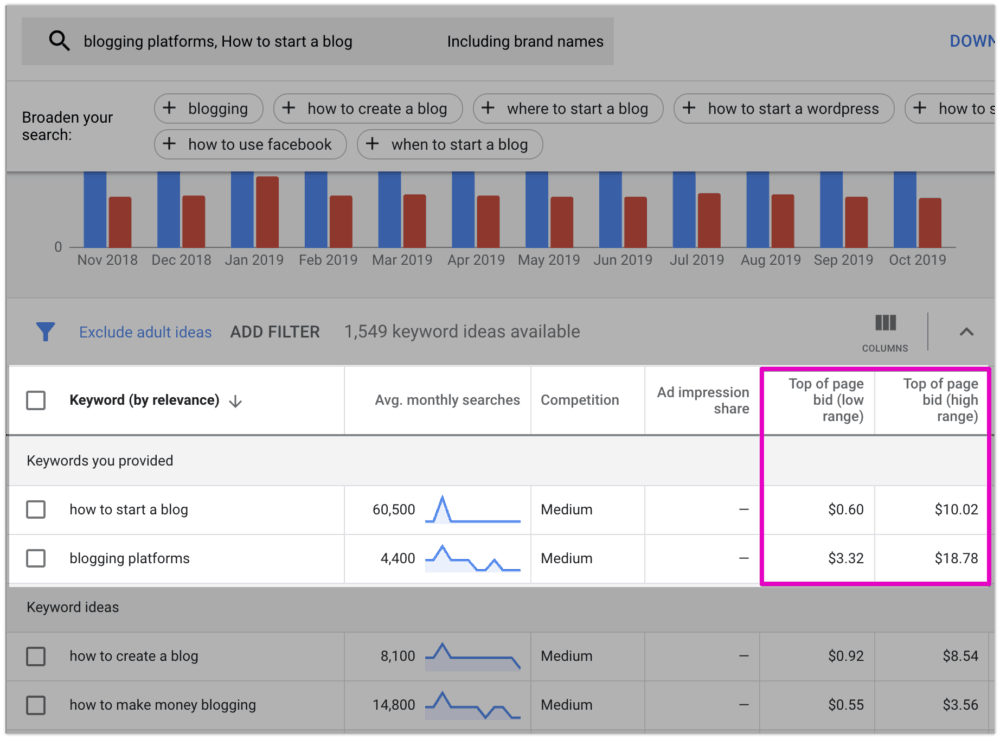
You can also see that “how to start a blog” gets far more searches each month than “blogging platforms” does: 60,500 vs 4,400.
(So the top-of-funnel keyword gets more searches, which is exactly what we’d expect.)
Don’t be afraid to repeat this process as more keyword ideas (or websites) occur to you.
It’s good to have a bunch to choose from.
Finally, download your keyword ideas from Google Keyword Planner so you’ll have a list to make notes on as we continue.
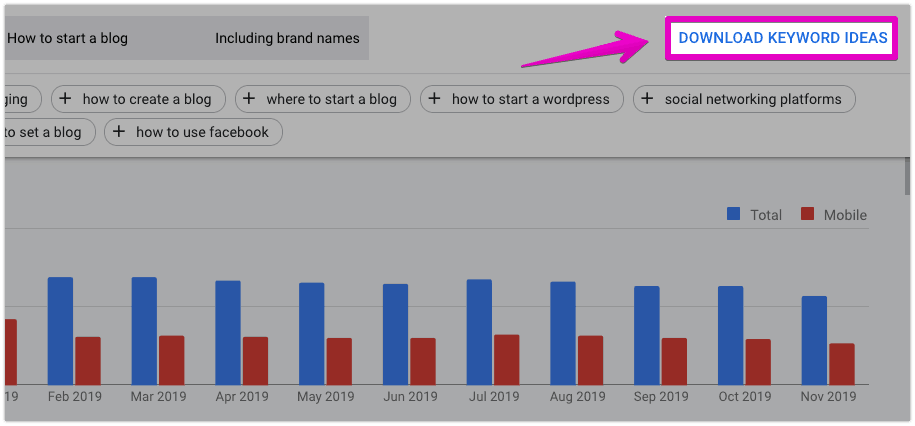
#2: Google your keyword ideas to see their organic results.
Now we’ll plug your best keyword ideas into Google.
There are three big reasons to do this.
The first reason is to see what type of content you should create for each keyword.
Should it be a product comparison?
A list article?
A case study?
You may already have some ideas.
But Google spends billions of dollars figuring out exactly what people want when they search for a given keyword.
It’s not perfect, but it does a great job 99% of the time.
Just search one of your keyword ideas on Google, scroll down past the ads, and look at what content is ranking well organically.
In the following example for the keyword “blogging platforms,” you can see the top-ranking pages are “how to choose” guides and “best blogging platform” lists.
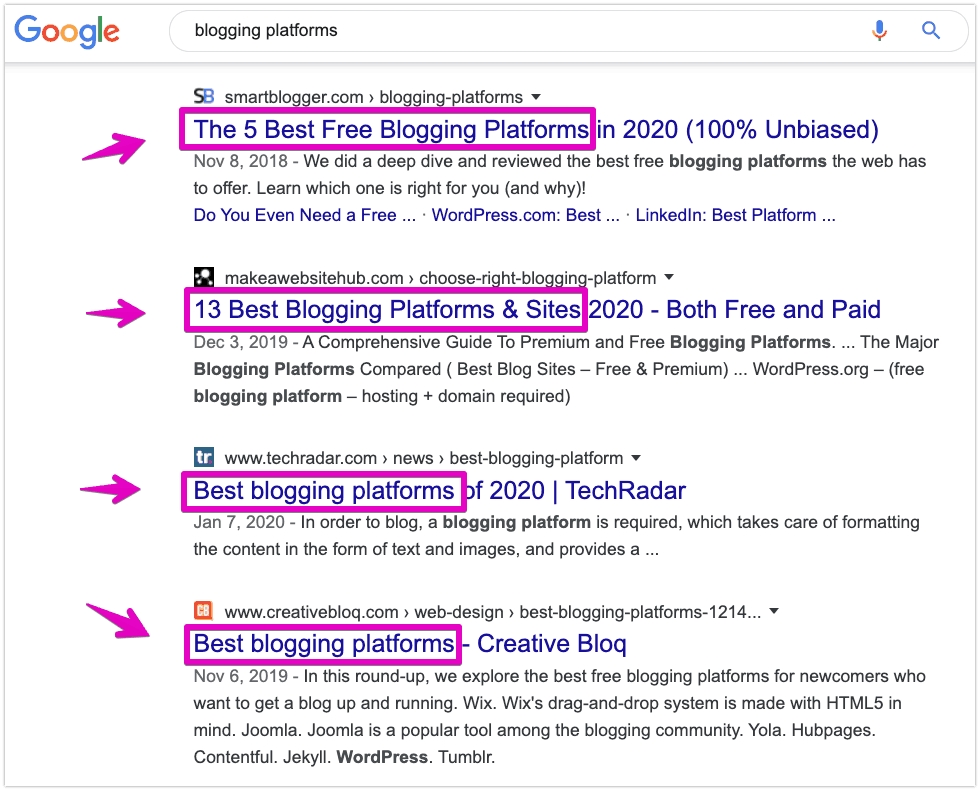
You can click into those results to see what the content looks like as well.
But even without doing that, you can already see what types of content are ranking well for this keyword.
The first result is a how-to guide that compares different blogging platforms, and the other results are all lists that compare different blogging platforms.
There aren’t any articles that focus on one specific platform, like WordPress or Medium — because Google has determined that that isn’t what people are looking for when they search for “blogging platforms.”
Those people are looking for lists of MULTIPLE options that highlight their differences, like this article from SmartBlogger:
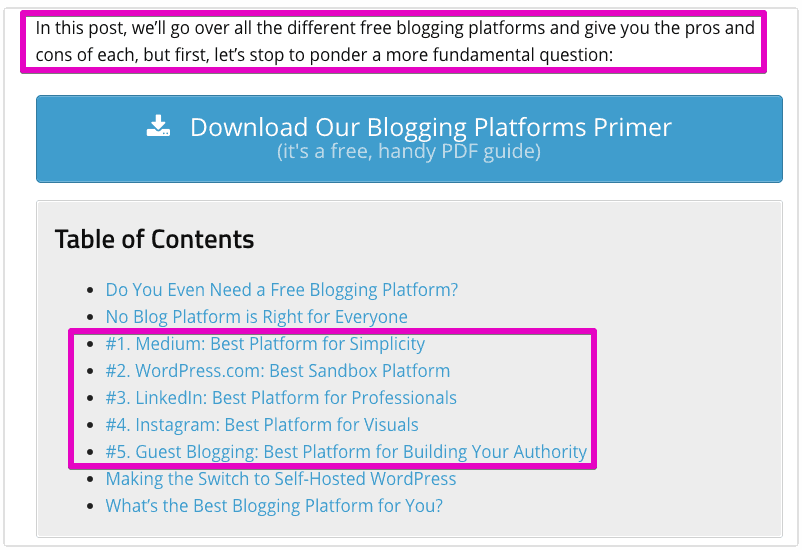
So that’s probably the type of content you should produce in order to target this keyword.
(Even if you really want to promote just one platform, including it in a list or comparison of multiple options will work much better at this stage than trying to solely push your own product.)
These results also tell us a lot about where this keyword will fit in your content marketing funnel: it’s all pretty general information.
Not pushing toward any particular product or service in order to convince people to buy it.
So this must not be a bottom-of-funnel keyword.
But we did see before that advertisers are willing to pay more per click for this keyword than for the “how to start a blog” keyword, which is even more general.
Based on what we’ve seen, “blogging platforms” looks like a middle-of-funnel keyword.
Someone searching for this keyword may not be 100% ready to make a purchase, but they are at least researching the options on their way to making a decision.
In your spreadsheet of keyword ideas, note which types of content are ranking well for each keyword you’re serious about.
And whether it would be a top-of-funnel, middle-of-funnel, or bottom-of-funnel keyword.
The second reason to Google your keyword ideas is…
To get even more keyword ideas.
The “people also ask” box at the top of the page (if there is one), and the “related searches” at the bottom of the page are both super useful for this.
They also give you additional clues as to what Google thinks the keyword is about (and therefore what topics you may want to address with your content).
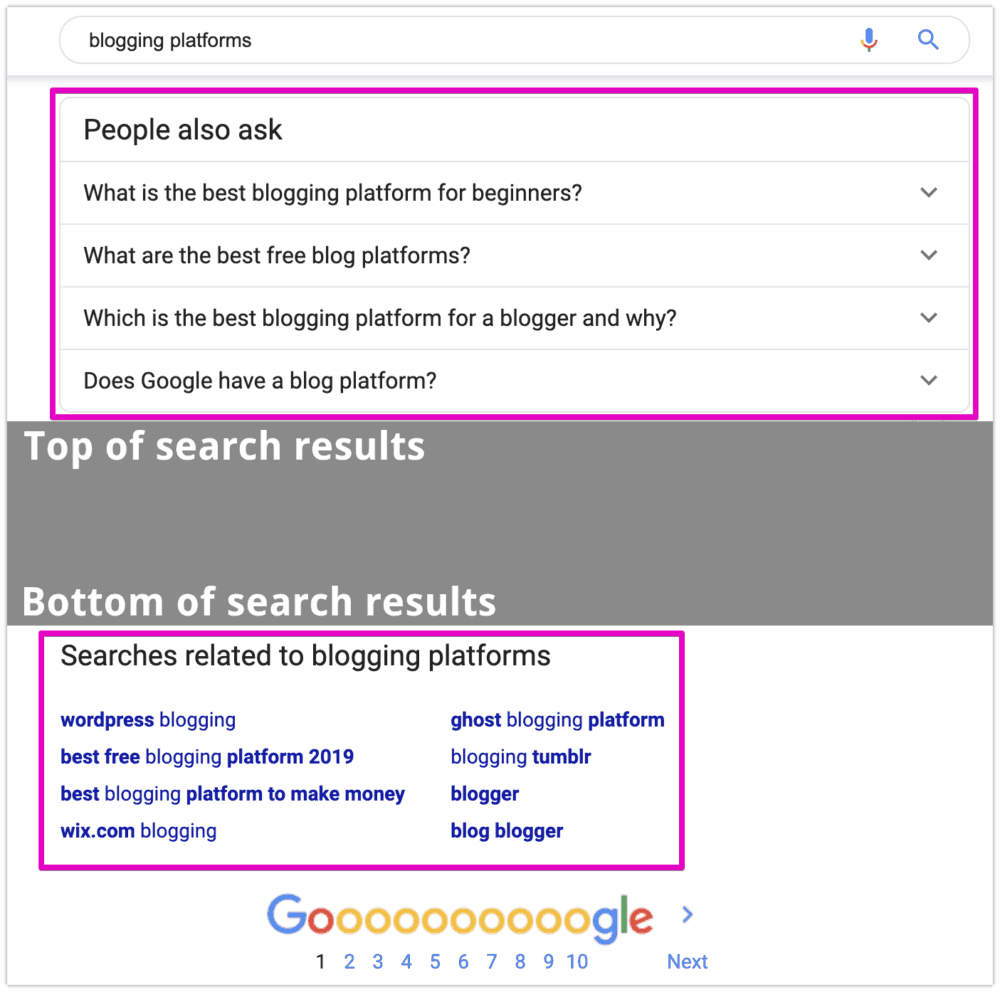
If you see any interesting ideas that you haven’t captured yet, plug them into Keyword Planner to get their details. Then add any winners to your spreadsheet of keyword ideas.
#3: Finally, use the MozBar to gauge competition.
The third reason to Google your keyword ideas is to see what the competition is like.
(Yes, Google Keyword Planner provides a “competition” score — but that’s only for advertising competition, not organic competition.)
Some people think that if you can produce the best piece of content on a particular topic or keyword, you’ll eventually rank #1 for it.
But that’s not how it works.
Established, authoritative pages and sites have a massive edge. They’ve gotten lots of backlinks, and as a result, Google trusts them.
If page 1 of Google is chock-full of those types of sites, that usually means you shouldn’t bother going after that keyword.
The easiest way to see whether that’s the case is by using the MozBar free browser extension.
Just pop over to the MozBar installation page and click the button to download it.
Once the MozBar is installed, when you search your keyword ideas on Google, you’ll see what each page’s PA (Page Authority) and DA (Domain Authority) are.
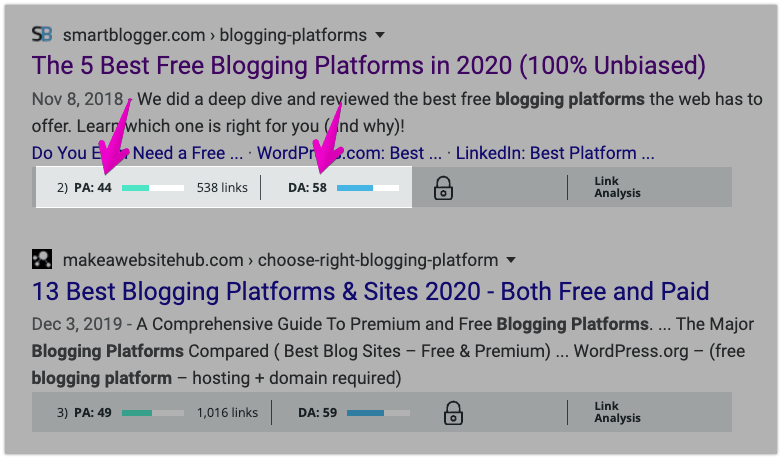
Both Page Authority and Domain Authority are on a 100-point scale, with 100 being the strongest.
Of the two, Page Authority is more important. It measures the individual page’s strength, and those with a very high PA will be very hard to beat. That’s why PA is the most important thing to look at when assessing competition.
Domain Authority is similar, but for the entire site. Sites with high DA have an easier time ranking than those with low DA. For example, Wikipedia has a DA of 98 which makes almost any Wikipedia page difficult to overtake.
But most of the time, as long as the page’s PA isn’t too high, you’ll have a shot at beating it.
And keep this in mind:
You don’t have to beat every result you see on the first page of Google.
You only need to beat one.
So as you look at the competition, keep your eye out for any “weak links” with a low PA and/or DA.
Then, compare what you see to your own site’s scores.
You can find out your own scores with the MozBar by simply visiting a page on your own site with the MozBar active.
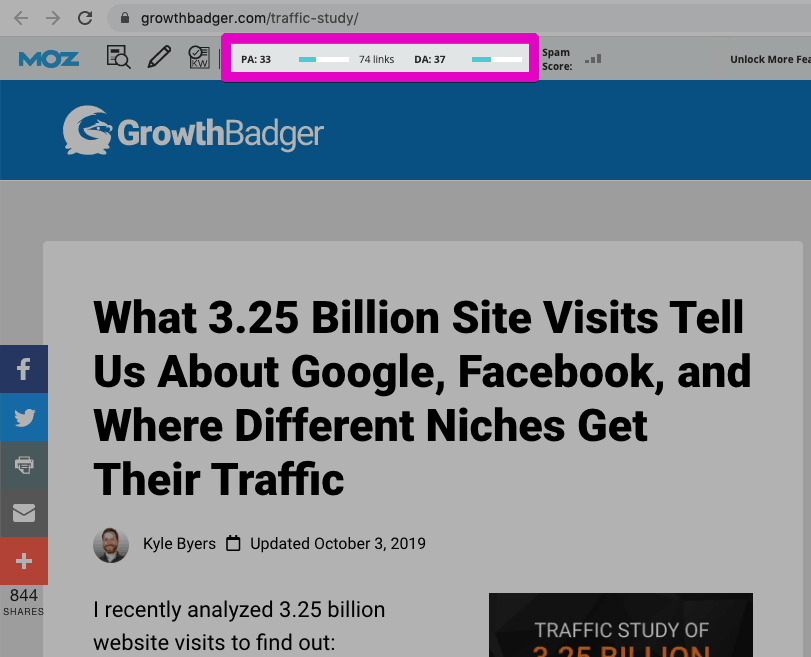
As long as there are at least one or two pages on the first page of Google with PA not much stronger than your own typical content, you should have a good chance at ranking well.
There’s one other thing to look at to gauge your competition:
Their content itself.
- How good is it, overall?
- Does it properly address the search intent behind the keyword?
- Is it really focused on the specific keyword or topic? (Or is it more geared toward something related, but different?)
If the top 5 results all have high PA, but their content sucks, doesn’t address the right search intent, or isn’t very focused on the topic, you may be able to beat them.
It’s important to be realistic, but pages with lower PA and DA can win if they do a better job in those areas.
In your spreadsheet, make notes on how competitive your keyword ideas are.
One last note about keyword intent before we move on:
Bottom-of-funnel keywords may not always fit into the bottom of your funnel.
For example, the keyword “Brooks Adrenaline GTS 19” refers to a specific model of running shoe made by Brooks.
The person searching that keyword probably wants to buy that shoe, or at least learn more details about it.
For Brooks, that’s obviously a bottom-of-funnel keyword.
So for Brooks (or retailers that sell Brooks shoes), it’s a good idea to send those people to a product page where they can read about that shoe, see pictures of it, read reviews, and buy it.
As you can see, that’s what Dick’s Sporting Goods and Amazon are doing:

But for Nike, this isn’t a bottom-of-funnel keyword at all.
The keyword does show buying intent…
But not for Nike.
Nike should treat it as a middle-of-funnel keyword.
They could create a piece of content comparing the Brooks shoe to the most similar Nike shoe, for example.
This is why you may notice that branded keywords often have lower CPCs than non-branded versions of the same keywords do.
The branded version of the keyword may be more valuable to that brand (or to its retailers), but the non-branded version is probably more valuable to everyone else.
Step 2: Evaluate Your Existing Content
Before creating a bunch of brand-new content, take a look at what you already have.
There’s a good chance you can tweak some of your existing work to help form the backbone of your content marketing funnel.
Think about what content already targets any relevant keywords or topics from your list — or that could be edited, refocused or expanded in order to.
If nothing comes to mind, use the “All Pages” report in Google Analytics to find ideas.
This report will show you which pages on your site are getting the most engagement from visitors.
Pop open Google Analytics, then go to Behavior -> Site Content -> All Pages.
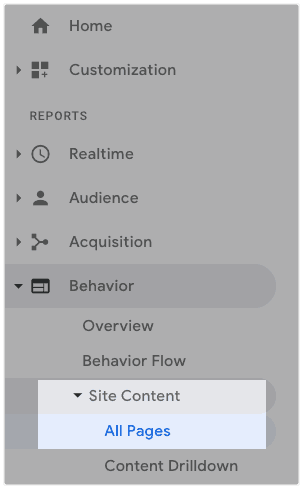
Here you’ll see a list of all the pages on your site, sorted by pageviews by default.
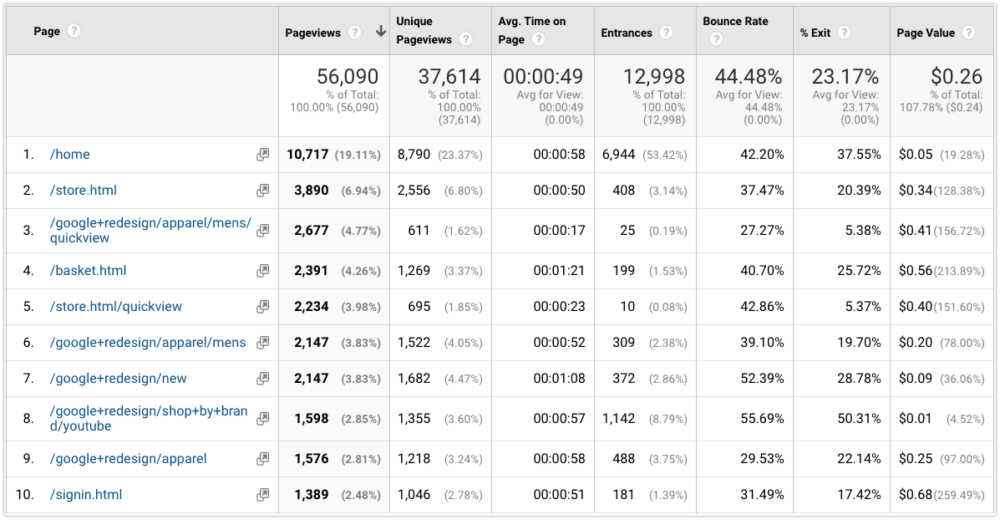
This gives you a list of your most popular content.
If you see anything that could work as part of your content marketing funnel, evaluate it based on keyword intent to determine where in your funnel it will make the most sense.
Then follow the remaining steps in this guide to fit it in and optimize it for results.
Now let’s set up your funnel.
Step 3: Outline Your Content Marketing Funnel
In the real world, there are a lot of ways you might close a sale.
Someone who hears about your product or service from a friend might go straight to placing an order or filling out a lead form…
While someone who heard you get interviewed on a podcast might Google your name and land your Twitter account and follow you for months before reaching out.
Don’t try to figure out every possible route.
For now, focus on creating a single, optimized path for getting people to notice you, trust you, and buy from you.
Start by making a simple outline.
Just write down the basics of what each step of your content marketing funnel will be.
If you want to make it purely SEO-focused, it could be three keywords from your list (one each from the top, middle and bottom of the funnel).
For example:
Top of Funnel, Awareness: how-to article targeting the keyword “how to start a blog”
Middle of Funnel, Interest: comparison list targeting the keyword “blogging platforms”
Bottom of Funnel, Desire and Action: case study targeting the keyword “WordPress hosting performance Kinsta vs WP Engine”
Or you could use SEO solely for the top of your funnel and rely on other marketing methods for later steps:
Top of Funnel, Awareness: general information article targeting the keyword “how long is a marathon”
Middle of Funnel, Interest: free 5-day email series on how to train for a marathon
Bottom of Funnel, Desire and Action: email offering discount on Brooks Adrenaline running shoes at the end of the marathon-training email series
Just make sure that the topic you cover in each step in your funnel is related to the topics in the other steps.
(Remember, you’re bringing people on a journey.)
You can also have one piece of content do double-duty.
For example, the marketing tool company Ahrefs has a very active, high-quality blog that gets a ton of traffic from Google.
And in each article, Ahrefs almost always does two things:
a) They thoroughly answer the question implied by the keyword they are targeting.
b) They talk about their product — a lot. Usually with screenshots.
Specifically, they talk about how to use their product in a way that’s related to the topic at hand.
Even when the keywords they’re ranking for are very general.
A perfect example is this page, which gets most of its traffic from the keyword “most visited websites.”
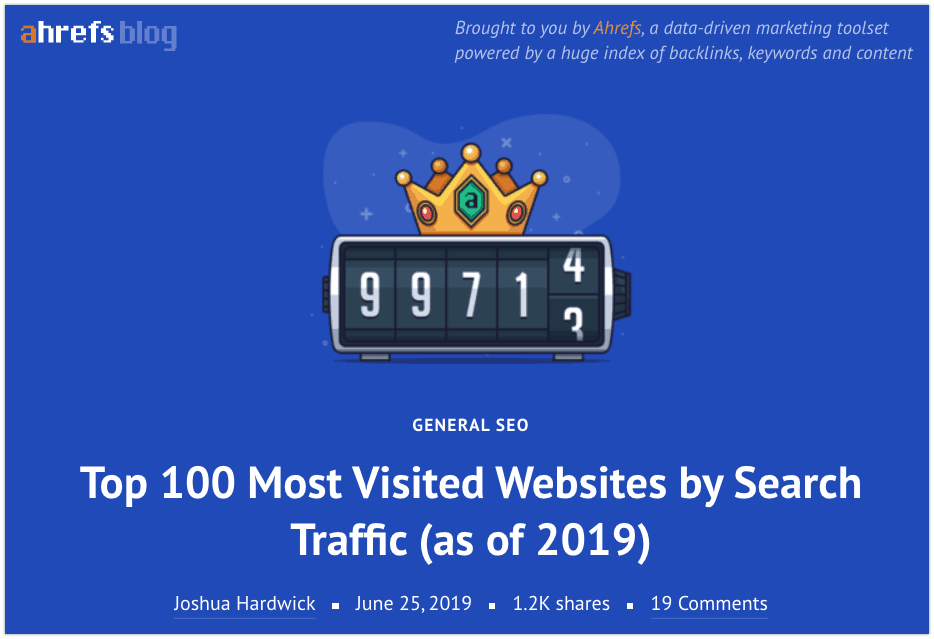
The post lists the top 100 most visited websites (by search traffic), then shows how Ahrefs used their own SaaS product to get more details about how those websites get so much traffic.
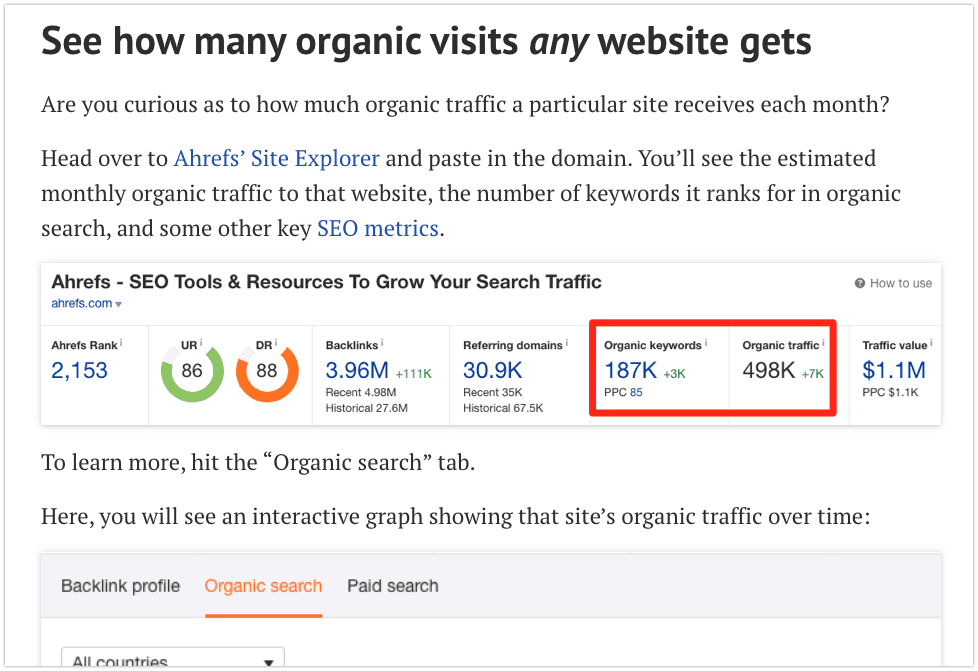
This approach effectively covers both Awareness and Interest (and maybe even a little Desire) in a single piece of content.
There’s nothing wrong with making your own content stretch across multiple levels of your funnel, as long as it feels natural and you’re still giving people what they want.
Go ahead and outline your content marketing funnel now.
Don’t worry too much about getting it perfect: you can always change it as you build out your content in the next steps.
Step 4: Create Your Top-of-Funnel Content (Awareness/Attention)
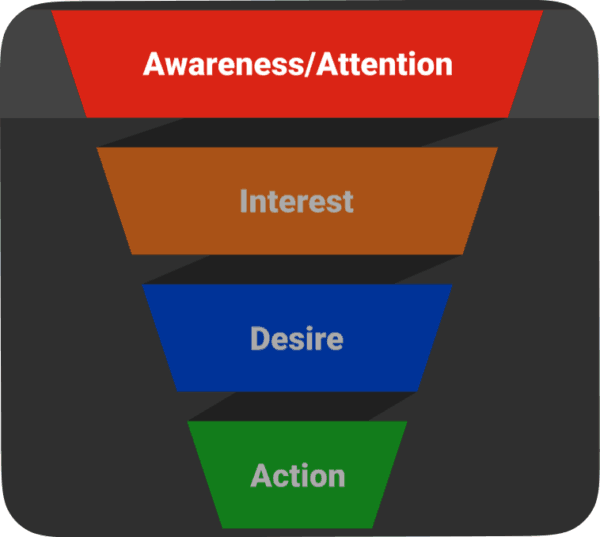
The main goal of top-of-funnel content (or “ToFu” content) is to create Awareness and get Attention from people who:
- Probably don’t know who you are yet
- Don’t know what you sell
- May not even know that they have the problem you are offering a solution to
But who are relevant enough to potentially buy from you later.
To ensure that’s the case, it’s best to make your top-of-funnel content at least loosely related to what you sell. (It doesn’t need to appeal to everyone, but it does need to appeal to the people who might buy from you.)
Publishing new top-of-funnel content also helps deepen relationships with people who already know who you are and what you sell, but who aren’t considering a purchase yet.
As long as your content continues to provide value to those people, it’s almost inevitable that they’ll consider buying from you at some point.
Why?
Because you’ve proven that you know what you’re talking about.
And you’ve built up an incredible amount of trust and goodwill.
I encounter this myself all the time. GrowthBadger is barely over a year old, but readers reach out to me every month asking to hire me — simply on the basis of the content I’ve published.
Some of the most common ToFu content formats are blog posts, YouTube videos, podcasts, interactive tools and social media posts.
When creating top-of-funnel content:
✅ Optimize for visits to fill your marketing funnel, but make sure the content is truly valuable to your target customers.
✅ Ask for an email address so you can continue to grow the relationship.
❌ Don’t push for a quick sale.
And since you’ll probably be relying on organic search for at least some of your traffic, a great guide to help you get more of it is Backlinko’s On-Page SEO: Anatomy of a Perfectly Optimized Page.
Here are two examples of great top-of-funnel content:
1. This how-to guide by the customer service SaaS company Groove:
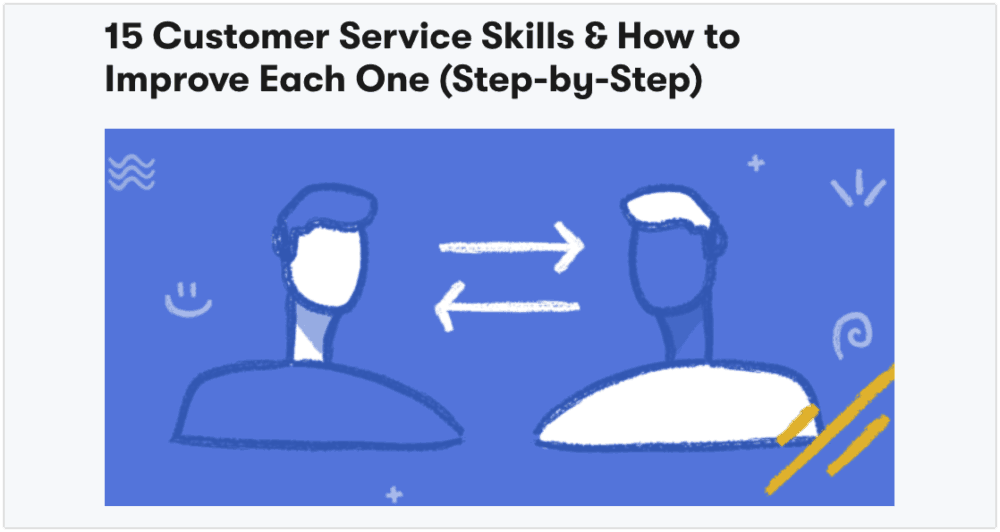
What makes it great ToFu content:
- Provides solid step-by-step tips on improving customer service skills.
- Ranks on the first page of Google for keywords like “how to improve customer service skills” and “customer service techniques,” which are the kinds of things a customer service manager — Groove’s ideal customer — might search for.
- Offers a free downloadable lead magnet in exchange for an email address.
2. This video series by video marketing software company Wistia:
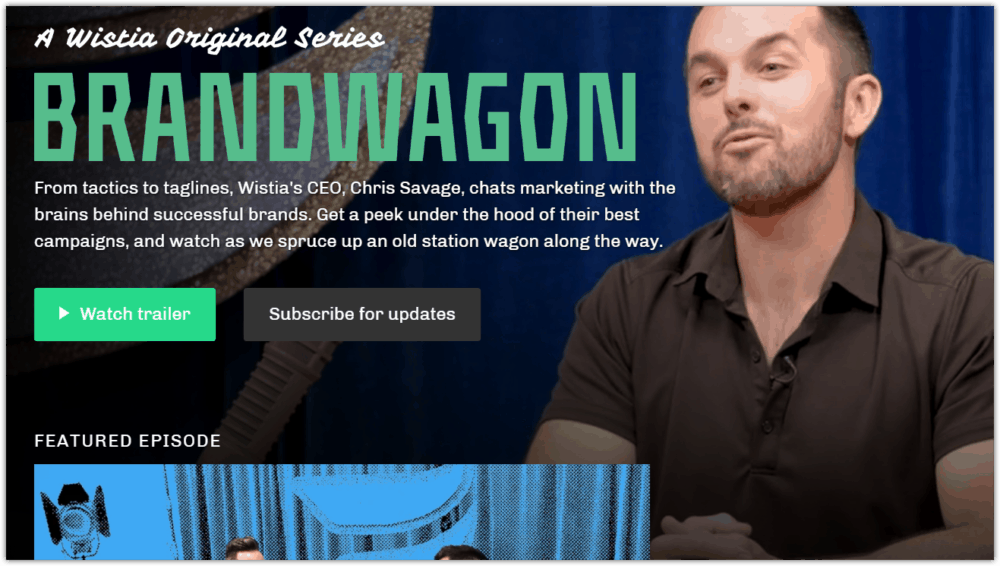
What makes it great ToFu content:
- Fun, retro format that begs to be shared.
- Content (interviews with big marketers) that appeals to Wistia’s target customer: marketing executives.
- Naturally showcases Wistia’s product: video marketing software.
Step 5: Create Middle-of-Funnel Content (Interest)
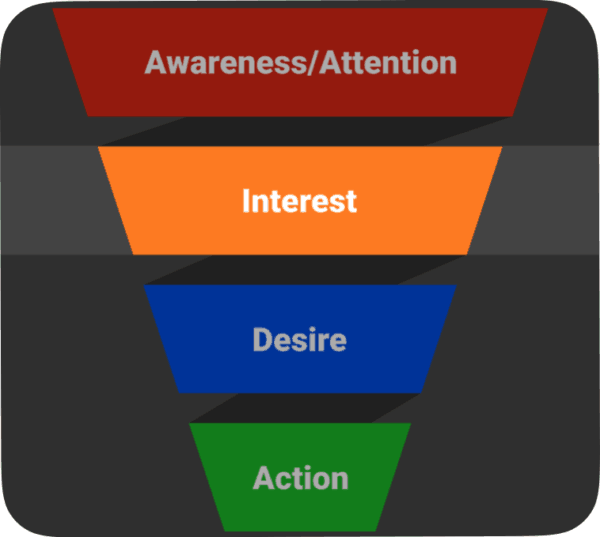
Your middle-of-funnel content (or “MoFu” content) should educate people about the problem or opportunity they have, and create Interest for the product or service you’re selling to help.
Middle-of-funnel content can also keep existing leads “warm.”
Many industries have sales cycles that take weeks, months, or even years to complete — MoFu content can help you stay on those prospective buyers’ minds so that when they are ready to buy, your product is the first one they think of.
In fact, the more complex and expensive your product or service is, the more important it is to have strong middle-of-funnel and bottom-of-funnel content.
No one needs to read an industry whitepaper before buying a pack of gum. So Wrigley doesn’t need middle-of-funnel and bottom-of-funnel content to target its end consumers. (Though it may help them sell to purchasing managers.)
On the other hand, no one is buying enterprise software on an impulse. So for enterprise software companies, MoFu and BoFu content is extremely important.
People who have made it to the middle of your funnel are much more likely to buy than people at the top, so each visitor at this stage is much more valuable. This makes it critical to create some way to follow up with them so that you can later bring them to the bottom of your funnel.
So if you haven’t already, this is the right time to ask for an email address or other contact info.
For that reason, “gated” content (that requires people to submit their information in order to access) is commonly used in the middle of content marketing funnels. For example, downloadable whitepapers, industry reports, case studies, email series, members-only blog posts, and in-depth product reviews.
Once your content marketing funnel is working well, you can also add fuel to the fire by promoting your middle-of-funnel content with paid advertising such as Google Ads or Facebook Ads (with tight targeting).
When creating middle-of-funnel content:
✅ Optimize for trust and value, showing off your expertise or product leadership and building a relationship with prospective customers.
✅ Get more specific as you educate prospects about the problem or opportunity at hand. This is also a good time to begin introducing the solution you sell.
✅ More aggressively pursue email addresses (or other contact info), possibly by requiring one in order to access the content.
Here are two examples of great middle-of-funnel content:
1. This industry report on how restaurants can attract more diners, published by restaurant reservation software company OpenTable:
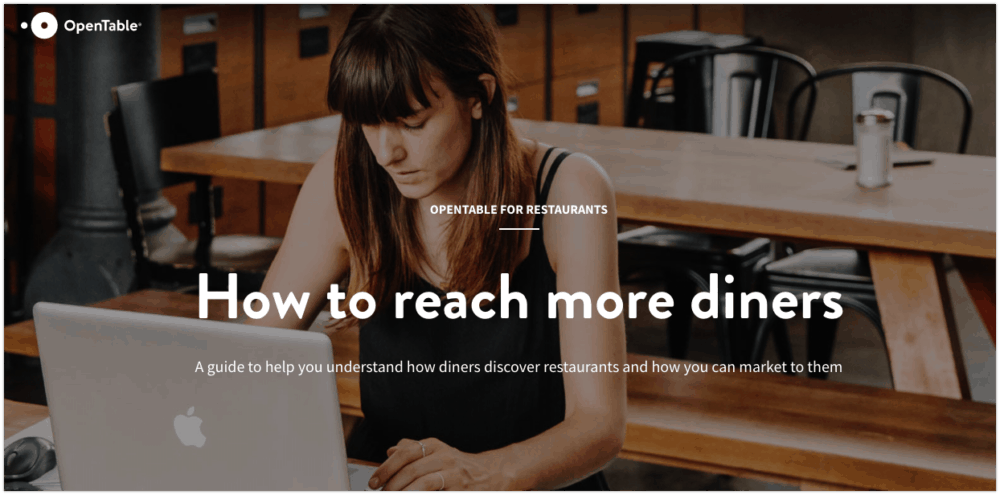
What makes it great MoFu content:
- Provides unique, valuable insights for the restaurant industry.
- Perfectly appeals to OpenTable’s ideal customer: restaurant owners/managers who want more diners. (One of OpenTable’s promises to restaurants is that it can help bring in more diners.)
- “Gated” so that it can only be accessed by providing your email address and contact info.
2. Author James Clear’s “3-2-1” email newsletter about productivity and forming habits:
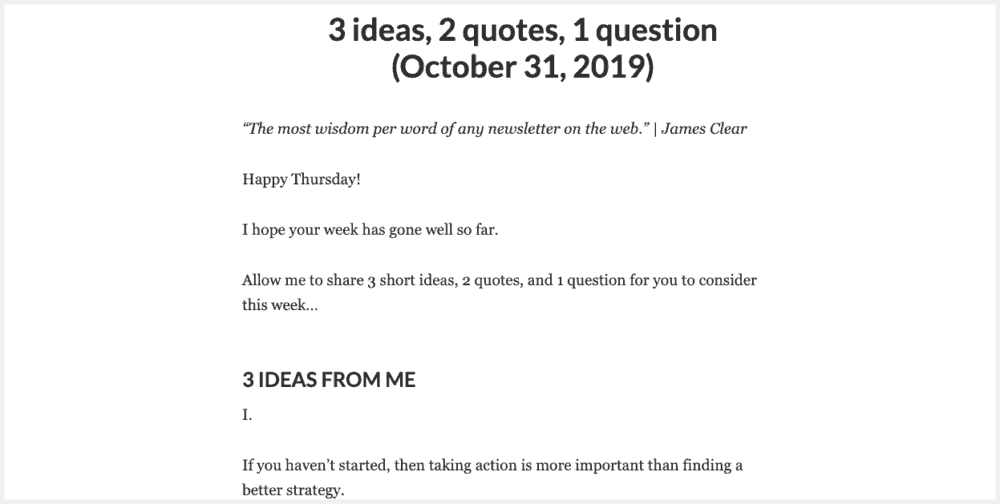
What makes it great MoFu content:
- Provides weekly tips on building good habits.
- Frequently (but naturally) references the author’s bestselling book on building habits as well as his premium course on the same subject.
- Builds an ongoing relationship with his audience while also nudging them toward his products.
Step 6: Create Bottom-of-Funnel Content (Desire and Action)
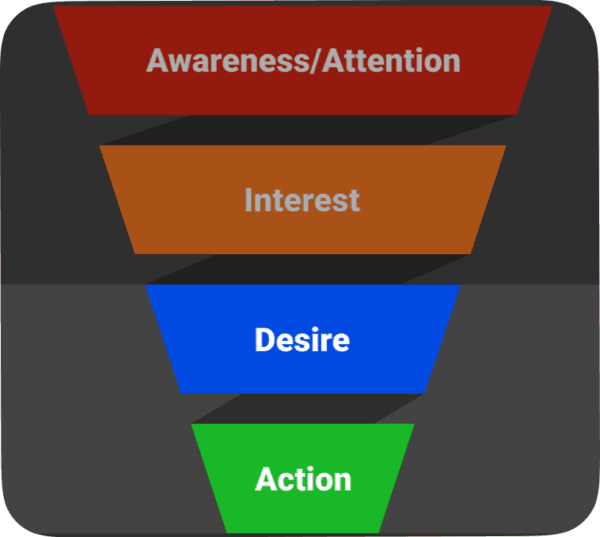
The goal of bottom-of-funnel or “BoFu” content is to create a burning Desire that gets people to take Action and buy your product or service.
This stage is low volume, but high impact.
Bottom-of-funnel content is often private, reserved for warm leads who are likely to buy.
For example:
Email launch sequences, sales-focused webinars, upgrade offers within freemium products, and live product demos. Even sales calls themselves could be considered bottom-of-the-funnel content.
Private bottom-of-funnel content is especially common for larger-ticket items sold B2B.
But if you’re selling B2C — or if the sales price or commitment isn’t too large — you may not need sales enablement content like that. Instead, a public product page, pricing page, sales letter or other single “buy” page may be all that’s needed at the very bottom of your funnel.
When creating bottom-of-funnel content:
✅ Make it clear how valuable your product or service is.
✅ Display product reviews or testimonials, and offer product tours/demos, free trials and consultations if applicable.
✅ Ask people to buy (and make it easy to).
Here are three examples of great bottom-of-funnel content:
1. The freemium product flow used by SaaS marketing tool company Moz. This content actually spans all 3 levels of the content marketing funnel:
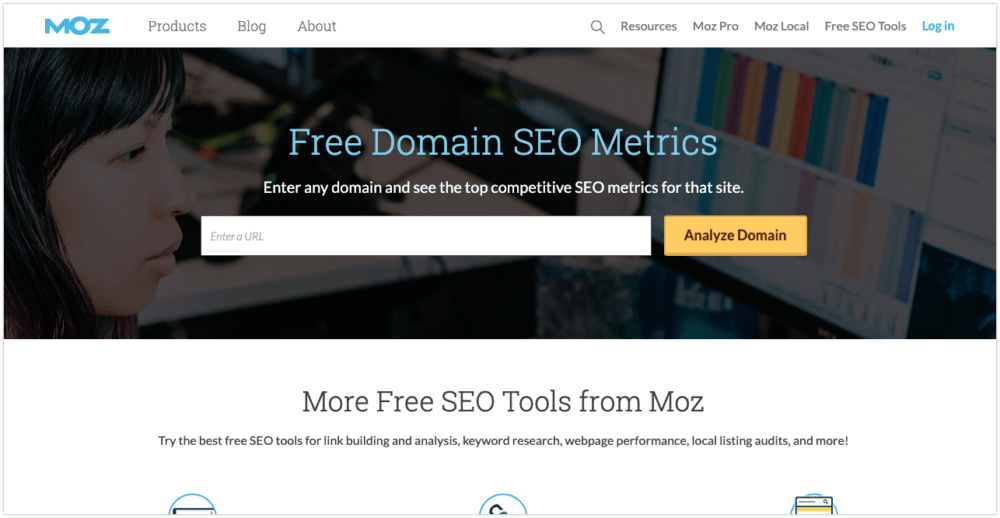
What makes it great BoFu content:
Moz’s approach to offering free tools is a perfect execution of the tried-and-true “freemium” model, and it stretches across every level of the content marketing funnel.
Here’s how it works:
Step 1: Someone searching for “SEO tools” finds the free tools page (entering the top of Moz’s content marketing funnel).
Step 2: Without any login requirement to add friction, the person tries the tools.
Step 3: After a few uses, the person is prompted to create a free account, signing up with their email address (and entering the middle of Moz’s marketing funnel).
Step 4: Now that Moz has their email address, the person also starts getting content dripped to them to build trust and deepen the relationship.
Step 5: Once they hit the usage limits on the free account, they’re invited to sign up for a trial for the full premium tools (entering the bottom of the funnel). When the free trial expires, they are prompted to pay for the full version.
This way, Moz automatically pitches the full, paid versions of the tools at the exact moment that people are most likely to buy them: when they’re using the free tools a lot.
2. Casper’s mattress product pages are perfect examples of the bottom of an ecommerce content marketing funnel:
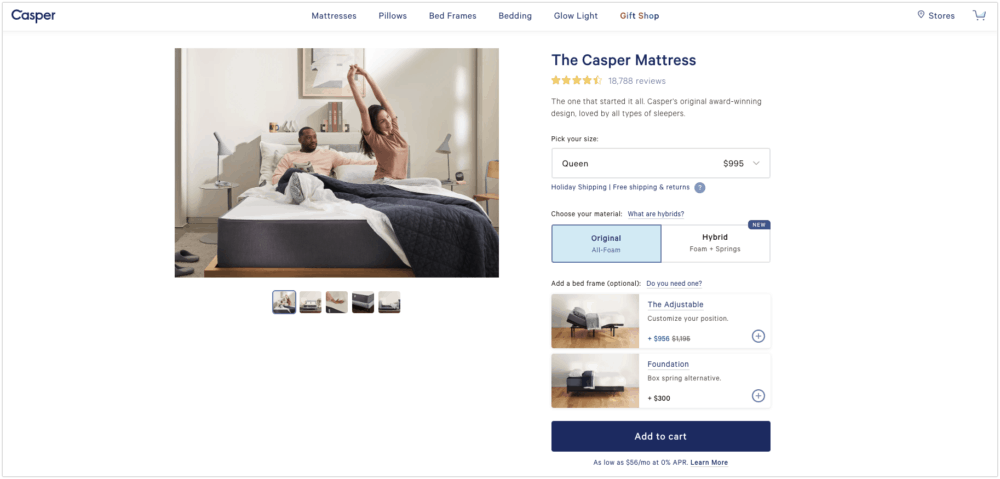
What makes it great BoFu content:
- Conveys the product’s value by displaying its features and benefits.
- Showcases customer reviews and testimonials for social proof.
- Makes it easy to order in as few steps as possible, and addresses potential objections like cost (by offering 0% financing) and risk (by offering a 100-day return policy with free shipping both ways).
3. ShipHero’s case study featuring Burst. Which is a great example of B2B content for sales enablement:
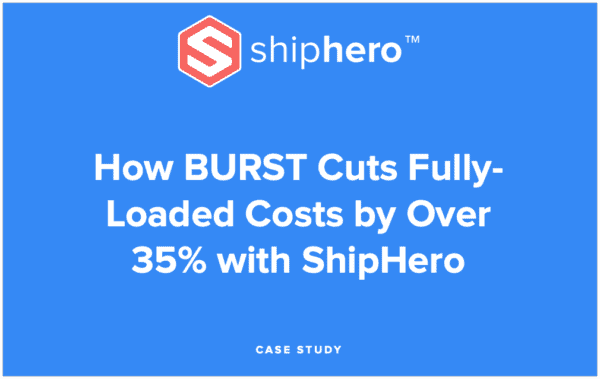
What makes it great BoFu content:
- Demonstrates the value of ShipHero’s services in concrete terms.
- Offers social proof.
- Is structured in a way that makes it easy to skim for busy corporate buyers.
Step 7: Strengthen Your Content Marketing Funnel to Reach “Effective Frequency”
So far, this guide has focused on creating a single, optimized set of steps for getting people to notice you, trust you, and buy from you.
Even a single path like that can be immensely valuable.
But the more paths you have, the more people you’ll be able to capture and convert.
So in this step, you can start creating additional pathways for people to enter your funnel — whether at the top, middle, or bottom.
Another reason it’s important to do this is a concept called “effective frequency.”
Effective frequency is the number of times someone has to see your marketing before they’ll make a purchase.
Different products and services have different effective frequencies: for a car it’s much higher than a can of Coke.
If you have no idea what your effective frequency is, a good rule of thumb is the Rule of Seven:
Assume that it will take at least seven different exposures to convince someone to buy from you.
Here are four ways to strengthen your funnel:
1) Add more content at each stage.
The more great content you have at the top and middle of your marketing funnel, the better.
More ToFu content = more new people entering your funnel.
More MoFu content = more chances to warm up subscribers and move them to the bottom of your funnel.
2) Repurpose your content to reach more people.
Marie Forleo has a YouTube channel with over 600,000 subscribers, and hosts one of the most popular self-improvement podcasts, and runs an active blog.
How does she do it?
By repurposing her content.
She turns many of her videos into podcast episodes:
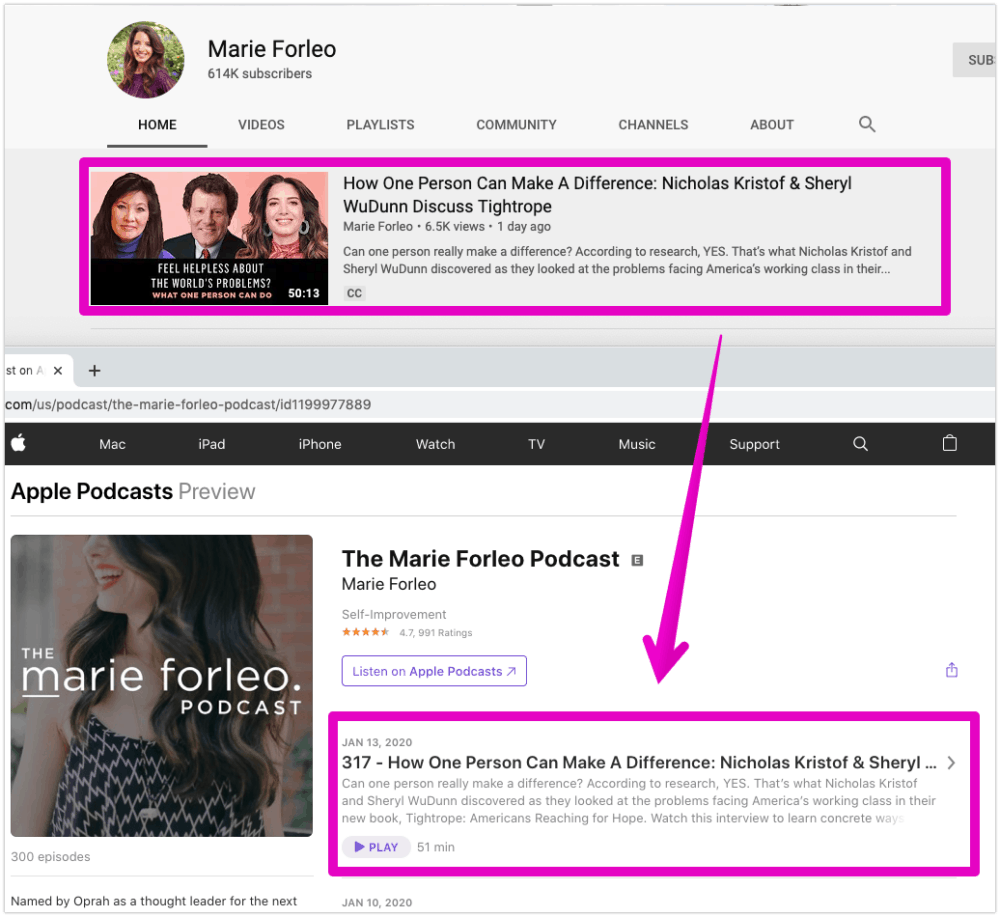
And she turns excerpts from her videos into short blog posts (with the full videos embedded for anyone interested).

Repurposing content takes way, way less work than creating new content for every single platform.
But it still gives you exposure to people you wouldn’t reach otherwise.
After all, different people prefer different formats.
Video works better for some, while others spend a lot of time to listening to podcasts in the car.
That’s what makes repurposing content one of the best ways to expand your content marketing funnel.
Turn your tweetstorms into blog posts, turn your blog posts into YouTube videos, and turn your videos into podcast episodes and Instagram stories.
3) Use direct distribution to move people between funnel stages.
The most important job of a content marketing funnel is to keep people moving.
You might have a ten million people watch one of your videos, but you’ll only get revenue from the ones who move to the next stage of your funnel.
The most powerful way to move people to the next stage of your funnel is through direct content distribution.
Meaning, nudging the specific people who are already in your funnel.
(Not just hoping they come back on their own.)
And the two best tools for direct distribution are email and retargeting.
Because they let you reach the people who have already entered your funnel, email and retargeting are your best weapons for hitting effective frequency and the rule of seven.
That’s why it’s so important to capture email addresses in the top and middle of your funnel.
How?
Give something valuable in return.
Use content upgrades or exit-intent popups to offer people a downloadable bonus PDF in exchange for their email addresses.
More than 80% of my email subscribers have come from content upgrades and exit-intent popups, even though there are 5 other places on my site for people to subscribe.
Here’s how one of mine looks:
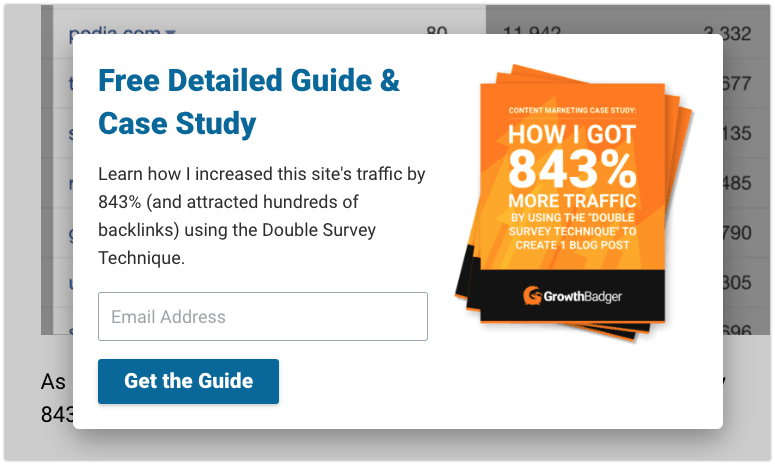
Or click here to see it in action (and hey, subscribe while you’re at it).
Then, drip out a steady stream of content directly to your subscribers, until finally making your sales pitch.
Retargeting is another great tool, and unlike email, it doesn’t require anyone to sign up.
Instead, you simply set up a snippet of code on your site to cookie your visitors. Then you can show them your ads when they visit millions of sites, ranging from Facebook and YouTube to CNN to specialty niche blogs.
The main retargeting options are to go directly through Google Ads and Facebook Ads (which allow for the most control), or to use a cross-network solution like AdRoll, Criteo or Perfect Audience (which make it a lot easier to manage).
Tip: don’t advertise to every person who has visited your site.
Serving ads to all your top-of-funnel visitors is a waste money.
Instead, only target people who have engaged with your middle-of-funnel and bottom-of-funnel content, didn’t end up converting, and haven’t come back in a while.
Use your ads to nudge them toward some new MoFu content they might like…
Then ask for their email address.
Here’s an example of the marketing software company NewsCred doing exactly that.
As you can see in the screenshot below, their retargeting ad (which was displayed to me on the Forbes site) leads to a middle-of-funnel landing page with gated content in the form of a how-to ebook:

Once you’re happy with how your retargeting is performing, you can test broader targeting methods: for example, using Facebook’s lookalike audiences or Google’s search ads with middle-of-funnel keywords.
This will allow you to bring even more prospects into your content marketing funnel.
Just make sure they’re actually converting for you in the end (which we’ll cover more in the next section).
4) Add a referral flywheel.
Your content marketing funnel doesn’t have to end at the bottom.
The best funnels grow organically, recruiting visitors to help spread the word to other people.
For example, the note-taking app Notion gives customers an incentive to tell their friends and followers.
Notion offers users $5 in credit for each person who signs up with their referral code (and the person who signs up will also get $10):

Similarly, the daily business newsletter The Hustle includes a sharing prompt at the bottom of each issue, next to a score of how many referrals you’ve brought in.
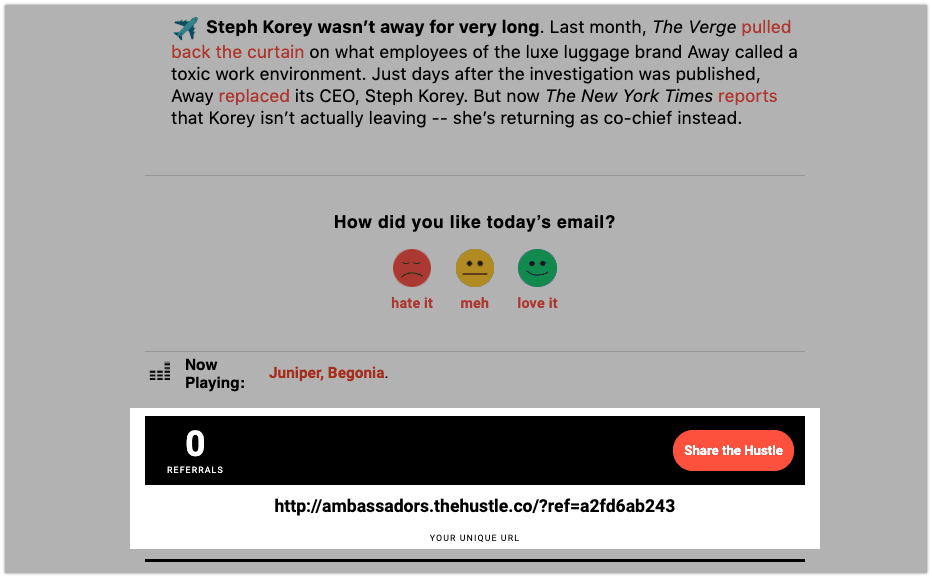
As people sign up with your referral link, you earn bonuses like access to The Hustle’s private Facebook group, special weekly emails from their CEO, a branded t-shirt and more.
Prompting people to share can even work without an incentive.
For years Amazon included a social share box on every order confirmation page, leading to tons of people telling the world about what they’d just purchased:

(Image source)
You can also encourage people to share your content before they’ve become a customer, while they’re still in the middle of your funnel.
The free tool Click to Tweet allows you to add pre-populated tweets to any blog post, in the form of clickable links.
Even simply asking readers, viewers or listeners to share your content can result in additional people coming into your funnel.
Step 8: Measure and Optimize Your Marketing Funnel’s Performance
No content marketing funnel is perfect.
There’s always room to improve.
In this step, I’ll show you three ways to get more customers from your marketing funnel.
Method #1: Fix engagement issues by using the “All Pages” report.
It’s time to revisit the “All Pages” Google Analytics report we looked at earlier in this guide.
To access it, go to Behavior -> Site Content -> All Pages.

This gives you a list of all the content on your site, along with some great information about how your content is resonating with your audience.

In particular, look at Avg. Time on Page, Bounce Rate, and % Exit.
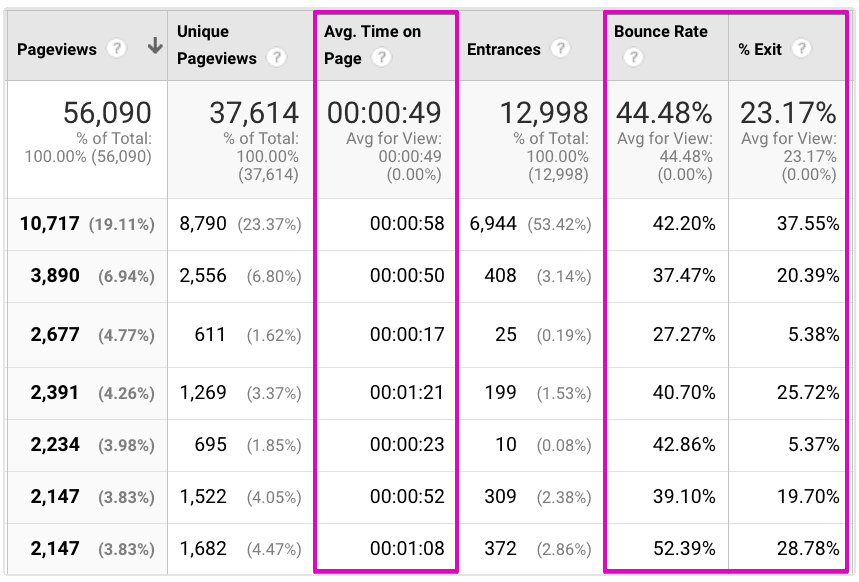
(And if you have goals with values assigned to them, look at the Page Value column as well.)
All of these numbers work together to show how on-target your content is.
Average Time On Page: generally the higher this number is, the more engaged people are with the piece of content.
If the core pieces of your content marketing funnel have much lower average time on page than others, it means they aren’t engaging enough — most likely because they aren’t properly addressing the intent behind the topic or keyword at hand.
Or it may be due to issues with the writing or structure itself.
Studies show that online content performs best when it is is concise and scannable, without rambling introductions.
That’s even more important for mobile users, which have outnumbered desktop users since 2017.
Which is why most of my sentences are short, and almost all of my paragraphs are only one or two sentences.
Bounce Rate is the percentage of visitors who entered on that page and then left without going anywhere else on the site. Therefore, a lower number is better.
People most often bounce because the page is not what they expected.
This may again indicate that the content isn’t addressing the visitor’s intent properly.
Or it could be that the page was loading too slowly, looked ugly, or had typos.
But bounces can also occur when the content simply answered the person’s entire question, leaving them with no need to visit other pages on your site or engage further.
While the visitor may be happy with that result, it’s not the best outcome for you because it means they weren’t interested in signing up for your email list or becoming a lead.
% Exit is what percentage of visitors to that page exit on that page.
What makes % Exit different from Bounce Rate is that for % Exit, it doesn’t matter which page the visitor entered your site on.
(They may have been to several other pages before they finally exited.)
Like Bounce Rate, it’s generally good to have your % Exit number as low as possible for each important piece of content. You want people to stick around on your site — at least until they subscribe, become a lead, or make a purchase.
Which brings us to the next important thing to measure:
Conversions.
Method #2: Set up conversion tracking so you can stop “flying blind.”
Conversion tracking is the only way to get a clear picture of how well your content marketing funnel is working.
Without it, you won’t be able to tell which pieces of content are driving actual results for your business.
Start by thinking about what each level of your funnel should achieve — aim to drive at least one specific conversion point with each.
For example…
Your top-of-funnel and middle-of-funnel content might be focused on bringing in email signups and social shares.
While your bottom-of-funnel content should be driving purchases, sales calls, lead form submissions and/or free trials.
Each one of those actions can be tracked as a conversion.
In Google Analytics, there are three ways to track conversions:
Goals, Events, and Ecommerce Tracking.
Goals are based on which pages people have been visited and how long they stayed there.
One of the most common types of Goal is “destination,” which counts each time someone lands on a specific page (for like an order confirmation page).
Goals can also be triggered based on Events.
Here are the four types of Goals:
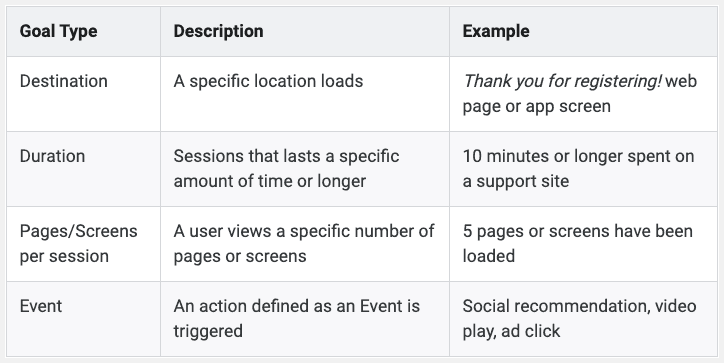
Here’s how to set up a Goal:
In your Google Analytics account, click “Admin” at the bottom of the lefthand nav.
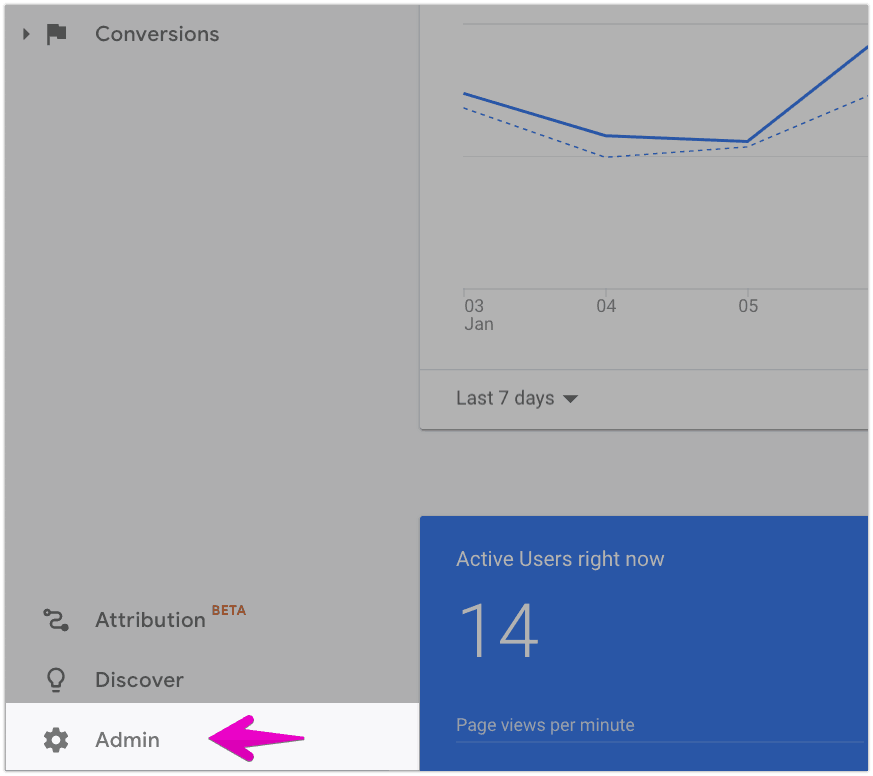
In the “View” column on the right, click “Goals.”
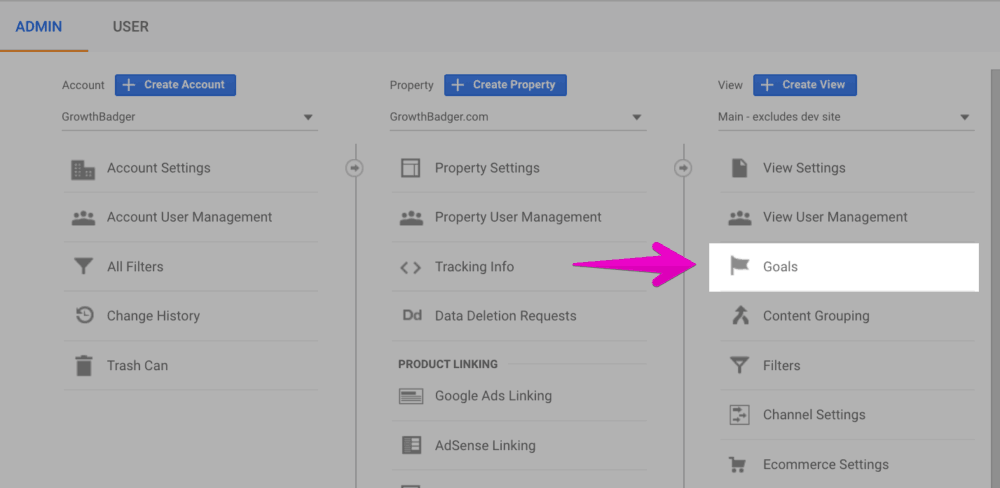
Then click the “New Goal” button on the right.

Now you’ll see a list of Goal templates.
You can click on one that matches what you want to track, or just click the “Custom” option at the bottom.
Then hit “Continue.”

Give your goal a descriptive name.
If you want, you can also change the Goal slot ID. This lets you organize different related sets of goals, and if you’ll be creating many goals it can help keep things organized. But it’s fine to just keep the default.
Then choose the Goal Type.
In this case, I want to measure email signups based on how many people land on the thank-you page. So I’ll select “Destination” and hit “Continue.”
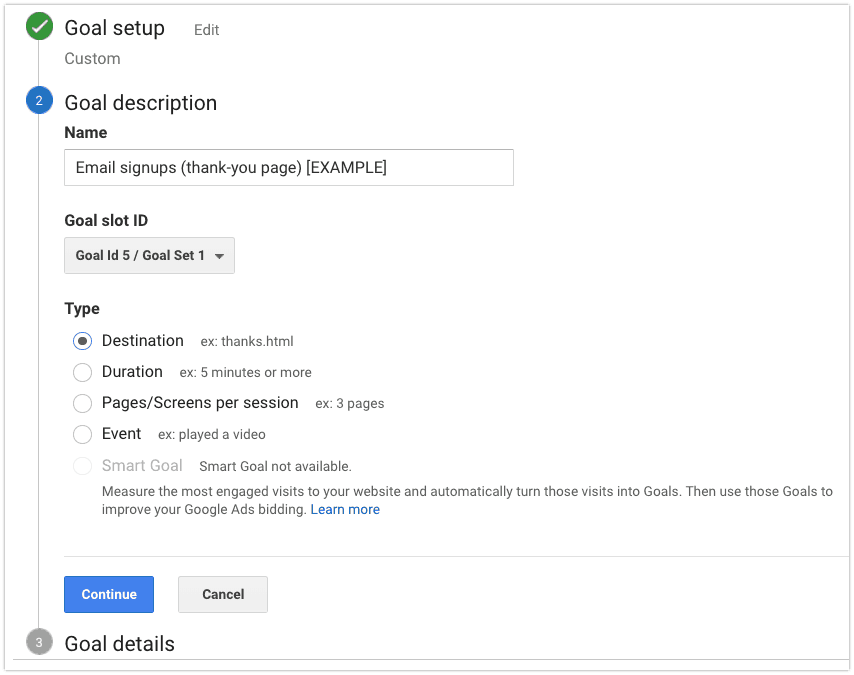
The last step is filling out the Goal details.
For a Destination-based Goal, that means adding the URL of the page you’d like to have trigger the Goal.
This would be the page people are sent to once they’ve converted.
In my case, the page people see after they’ve signed up for my email list is https://growthbadger.com/email-signup-thanks . (It’s actually not, but let’s pretend.)
Analytics uses relative URLs, so instead of writing the full URL here I’ll just put “/email-signup-thanks”.

You can also add a monetary value to each conversion if you’d like. For example, if you know that each email subscriber is worth $10 to your business on average, you could set this to $10.
This is especially useful for non-ecommerce businesses where most conversions are not directly tied to revenue.
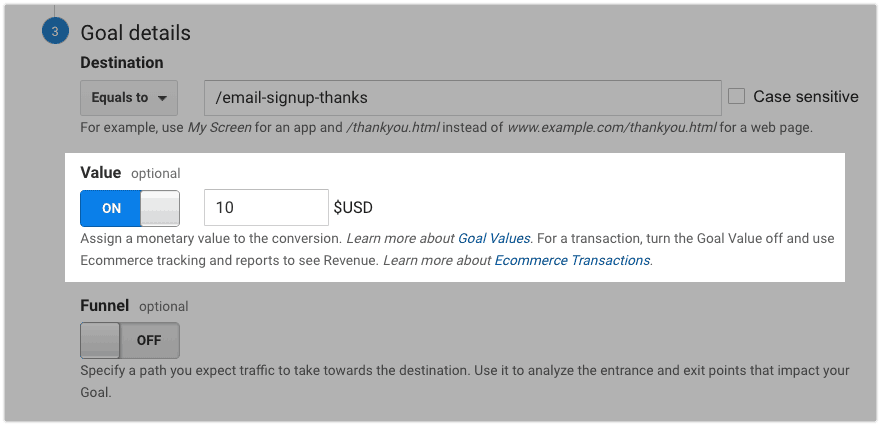
Last, the optional “Funnel” switch lets you track how your marketing funnel leads to this Goal.
This feature allows you to use the Funnel Visualization report later, which can be helpful to spot dropoffs in your conversion flow if there are a number of specific steps people need to take in order to convert.
For example, if you have a two-step form for filling out a lead form, adding the URL for each step here would allow you to see how often people cancel out of the process at each step.
Here’s how that might look:
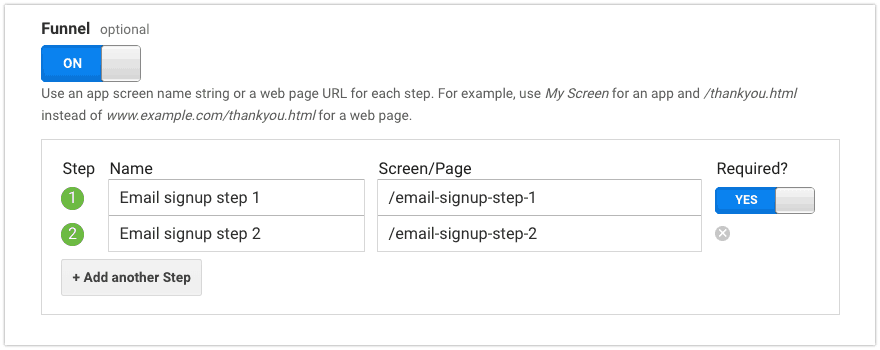
Note: enabling this feature doesn’t affect how many Goals are counted; only how many are shown in the Funnel Visualization report.
I don’t have a multi-step process for email subscriptions, and people can subscribe to my list from lots of different pages, so I would leave the Funnel option off in my case.
Finally, you can save your Goal.
There’s also an option to verify you’ve set it up correctly, which is useful if you know people would have converted in the past week.
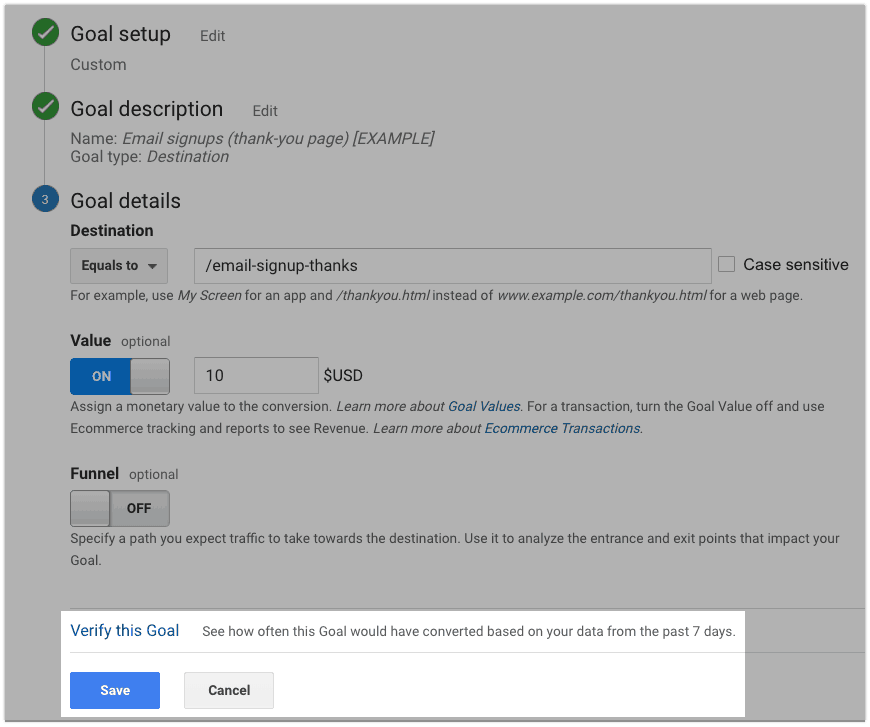
You can repeat this process to set up additional Goals, up to 20.
Now let’s talk about Events.
Events allow you to track more things than Goals alone.
Unlike Goals, Events can be triggered when an action is taken that doesn’t load a new page — like someone clicking on a button to watch a video or submit a form.
For example, if your email signup forms don’t send people to a thank-you page.
Though as you saw, you can later create Goals that trigger based on any Events you set up.
There are two ways to set up an Event:
- The easier way, via Google Tag Manager
- The more technical way, using JavaScript tags
Google’s instructions for both methods can be found here.
Using Events, you can track things like:
- Lead form submissions
- Video views (including triggers based on % watched)
- Social sharing button clicks
- Whitepaper downloads
- Webinar signups
And more.
This will allow you to tie all those different actions back to the pieces of content that are driving them.
Note: Events also affect reported bounce rate. If someone enters a page, triggers an Event on that page and then leaves, it will not be counted as a bounce — whereas without the Event, it would be.
Once you have your Events set up, you can trigger Goals based on them.
Just go back to Admin -> Goals -> New Goal again…
Only this time, in step 2 choose “Event” as the type.
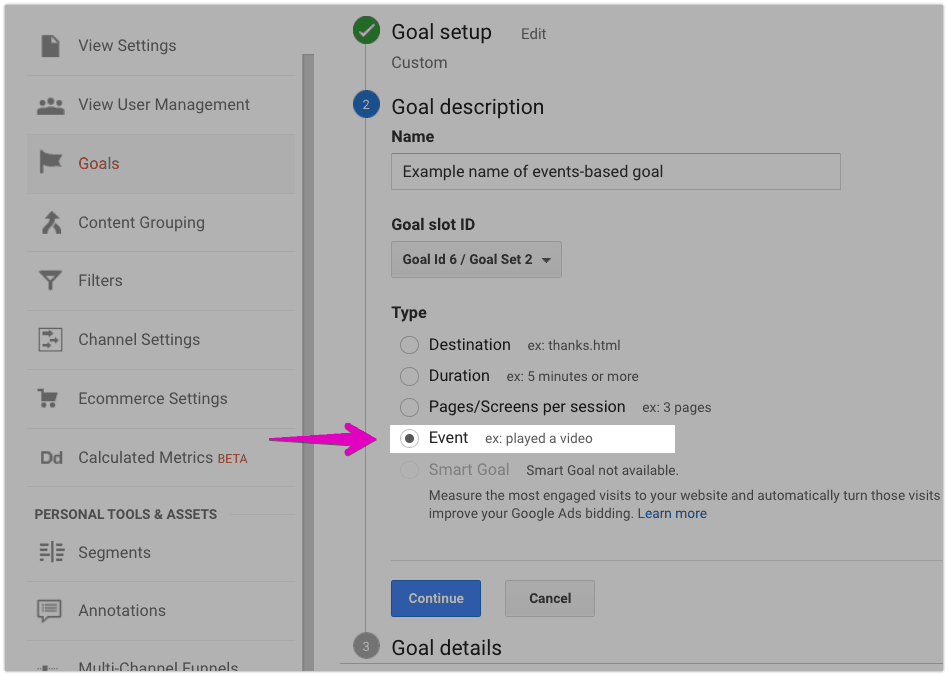
Then you’ll tell Google which Event the Goal should trigger from.
This can be based on the Event’s Category, Action, Label, and/or Value (which you chose when you set the Event up).
You can also choose whether to use the Event Value for the Goal Value, set a new Goal Value or use no Value.
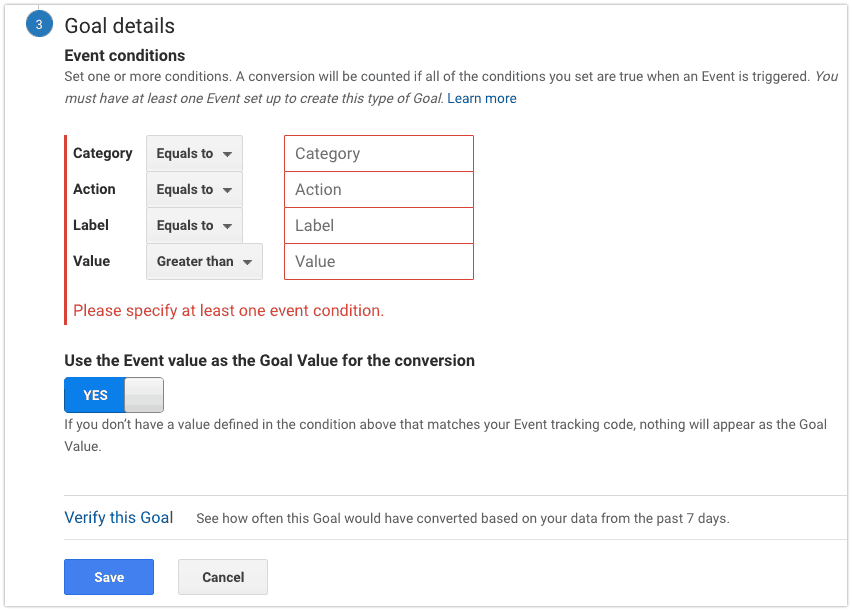
Finally, you can verify and save the new goal like usual.
If you already have Events set up without Goals attached, you can see data for them in the Events reports found under Behavior in the lefthand nav menu.
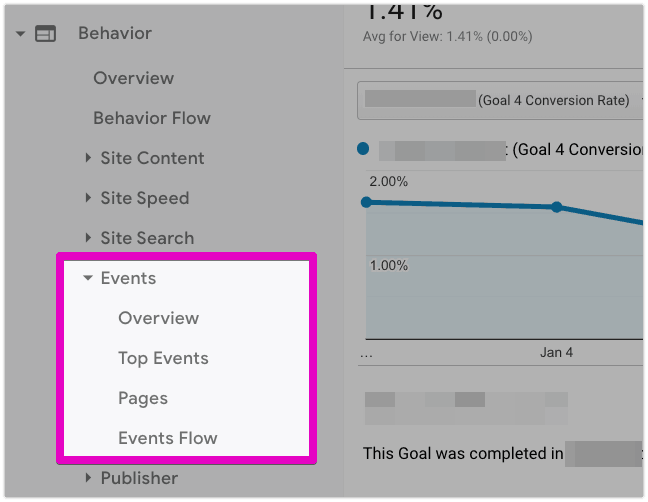
The last conversion tracking method, Ecommerce Tracking, is incredibly valuable for ecommerce sites.
It pulls all your transaction data into Google Analytics as it happens, attributing purchases and revenue to the specific pages, traffic sources, geographies (and more) associated with them.
![]()
If you run an ecommerce site and aren’t using ecommerce tracking yet, here’s Google’s guide to setting it up.
Method #3: Monitor and optimize your conversions from content marketing.
Now that your conversion tracking is set up, it’s time to see how many conversions your content is driving.
There are a lot of reports that will show you this data.
But I have a couple of favorites.
The first is the All Traffic report, found under Acquisition -> All Traffic -> Channels.
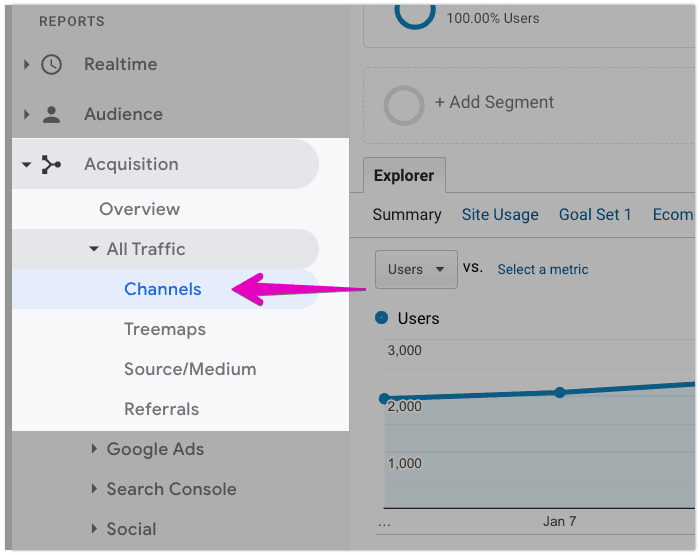
This is probably the most important report in all of Google Analytics.
It allows you to see which traffic sources and pages are bringing in traffic and conversions.
It starts at a very high level, showing data for a handful of broad channel groupings:
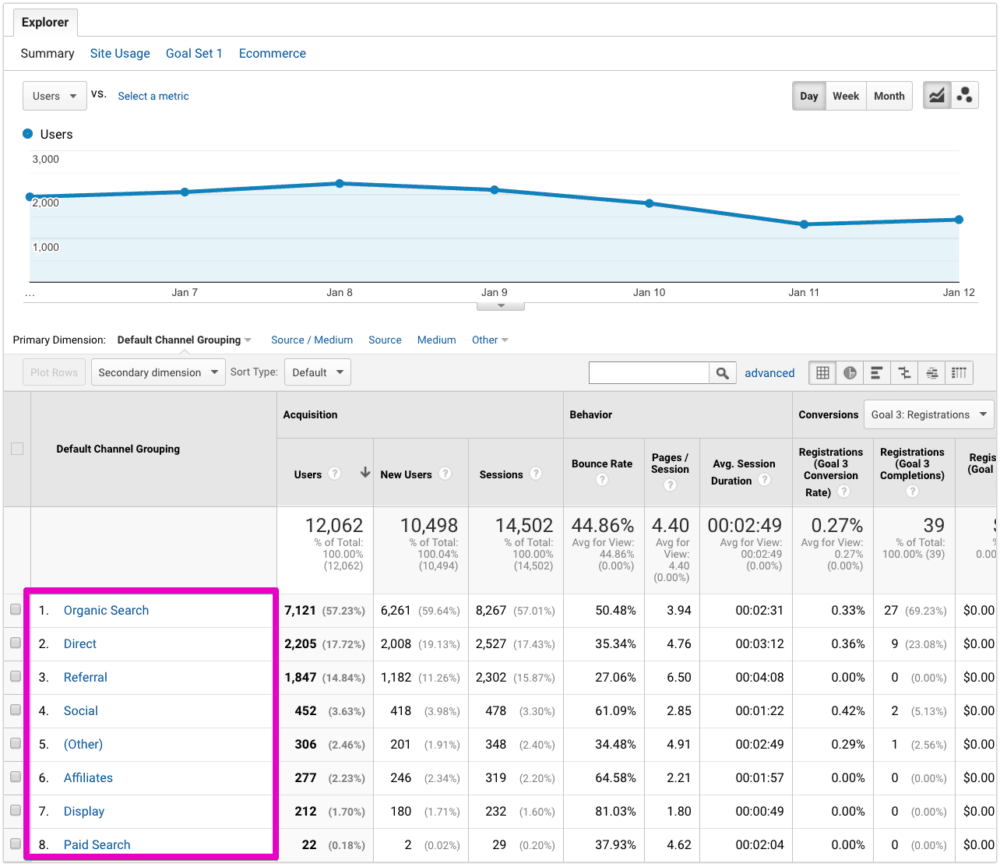
But if you click into a given channel, you can see more specifics.
For example, clicking on the “Referral” channel will drill down a level to show which specific sites are referring traffic:
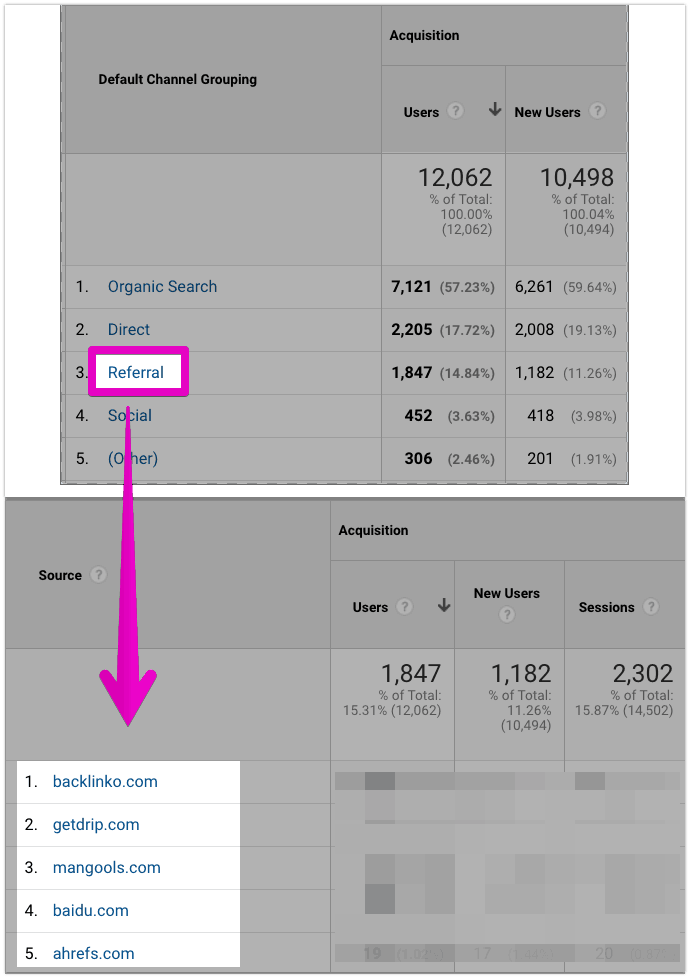
At each level of this report, you can see how much traffic each source is bringing in, as well as behavior metrics like bounce rate and pages per session, and, most importantly, conversions.
And you can use the “Conversions” dropdown menu to change which conversions it shows.
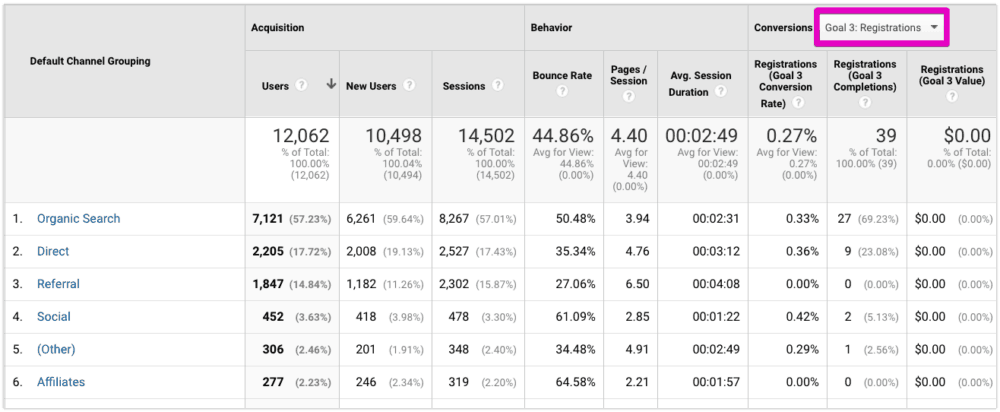
You can choose eCommerce (if you have ecommerce tracking set up), All Goals, or an individual goal.
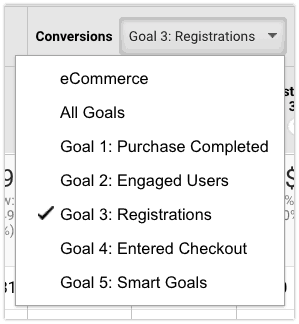
In this same report, you can also see where people are entering your site from each traffic source by adding landing pages as a secondary dimension.
Just click the “Secondary dimension” dropdown menu and then type start typing in “landing pages” until it comes up as an option to select.

That will give you a view like this, with landing pages tied to traffic channels:
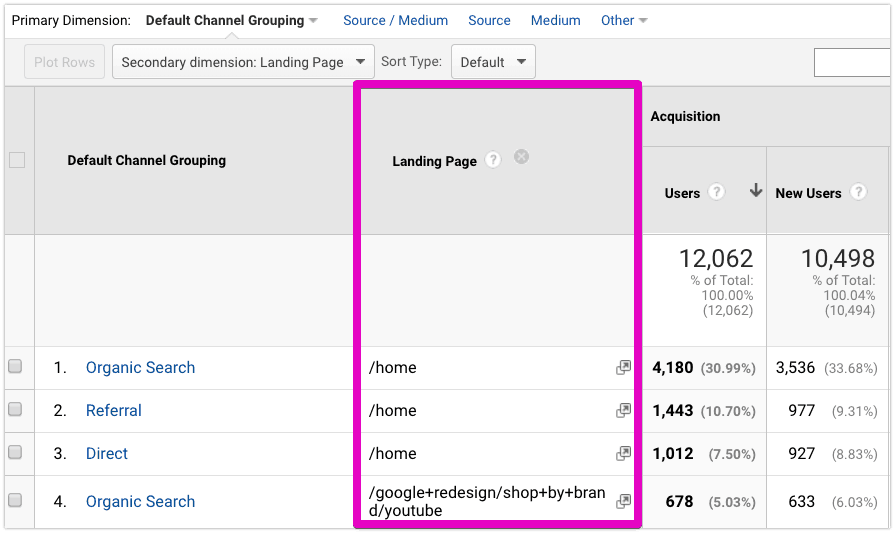
Of course, as you can see above this will often mean the same landing page showing up multiple times.
So if you’d like to see landing page data irrespective of traffic source, change the primary dimension instead. Just click the “Other” dropdown menu up in the primary dimension area, then start typing “landing page” and click that option when it comes up.
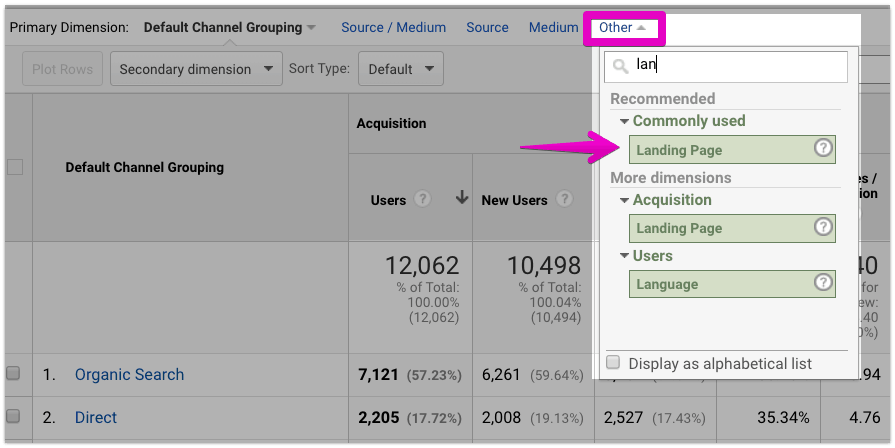
Now you can see how your landing pages are performing, including all the same conversions data you had for traffic channels.
With this information, you can focus more on the traffic sources and content strategies that are paying off and waste less time on the ones that aren’t.
My other favorite way to see the conversions from your content marketing funnel is the Multi-Channel Funnels report group.
Remember how we talked about Effective Frequency: the concept that it takes multiple “touches” with a single person before they will convert?
Well, the problem with most Google Analytics reports is that they give all the credit to the last page and traffic source that led to a conversion.
This is called “last-touch attribution.”
(Technically Google Analytics defaults to “last non-direct click” attribution, but it causes the same problem.)
Those reports ignore all the other touchpoints that contributed along the way, making it hard to see how big of a role your top-of-funnel content is really playing.
The Multi-Channel Funnels reports (aka MCF reports) help solve this problem.
This group of reports will show you the different traffic sources and pages of your site that are contributing to your conversions…
From the very first time someone entered your site to the last time they came back before converting.
I’m going to show you the “Top Conversion Paths” report in particular.
To access it, navigate to Conversions -> Multi-Channel Funnels -> Top Conversion Paths.
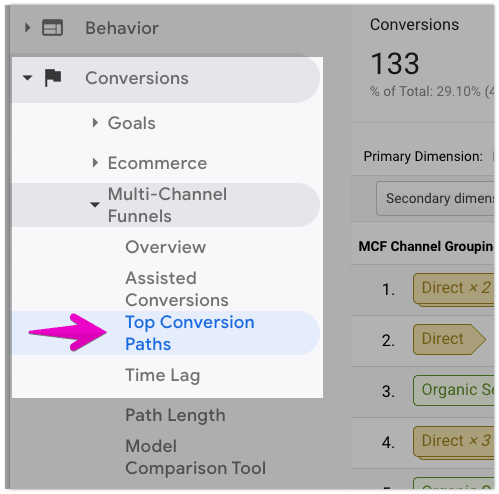
This will bring up the top multi-step paths people took on their way to converting.
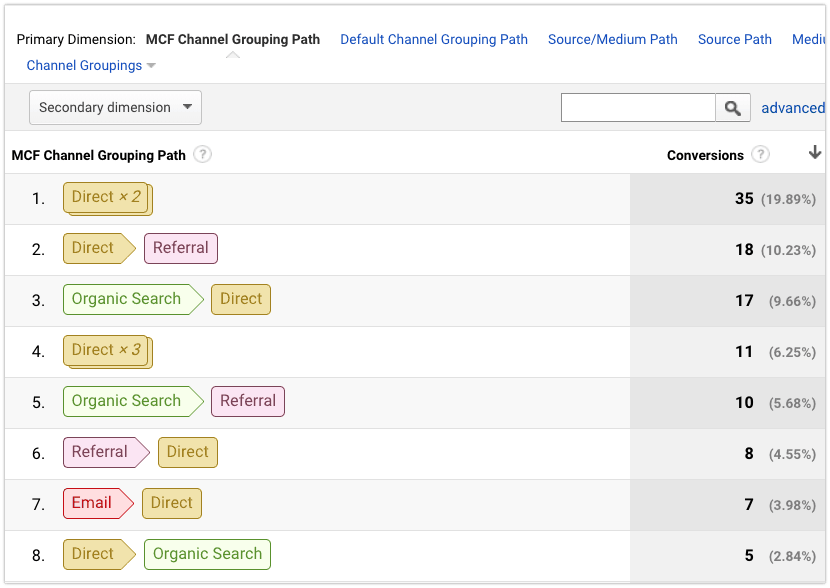
In my case, you can see above that the three most common ways people are converting on my site have each taken two visits:
- Direct x 2 (they first came as a direct visitor, then came back the same way again)
- Direct -> Referral (they first came as a direct visitor, then came back as a referral from another site)
- Organic Search -> Direct (they first came via organic search, then came back as a direct visitor)
(Keep in mind that “Direct” is Google’s catch-all term for unknown traffic sources. It includes anything from people who typed your URL directly into the address bar or used a bookmark to untagged email campaigns.)
This is already interesting info, but it would be a lot more useful if I could see which pieces of content were responsible for these visits.
Luckily, like in the last report, we can change the primary or secondary dimension to see landing pages.
To add it as a primary dimension (replacing the traffic channels), click either the “Other” dropdown menu in the Primary Dimension row.
Or to add it as a secondary dimension (alongside the traffic channels), click the “Secondary dimension” dropdown menu.
Then start typing “Landing Page URL Path” until you see that option come up, and select it.
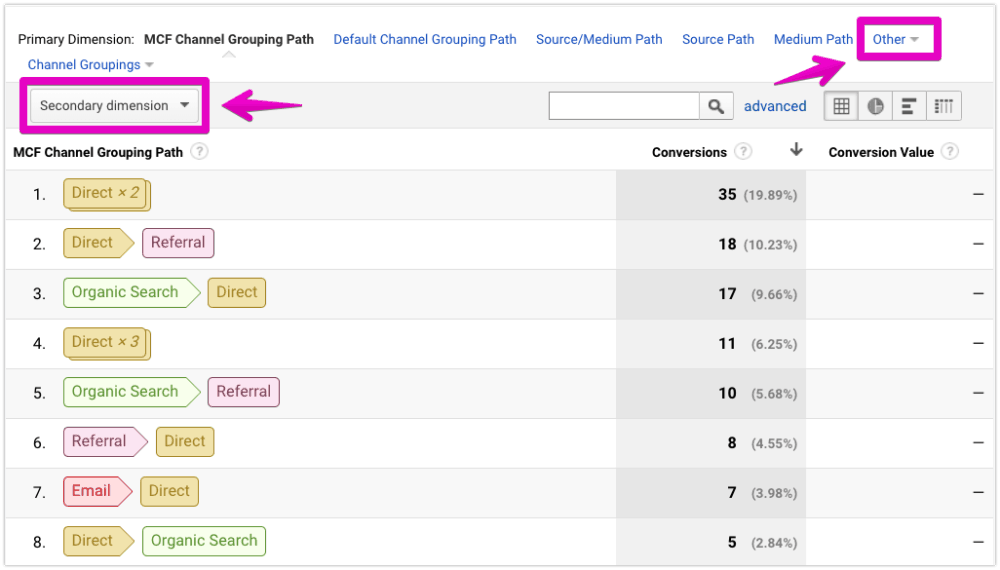
I’d still like to see the traffic channels, so I’ll add it as a secondary dimension.

Now you can see that the most common conversion path is people coming directly to the homepage twice, which accounts for 6.82% of my multi-step conversions.
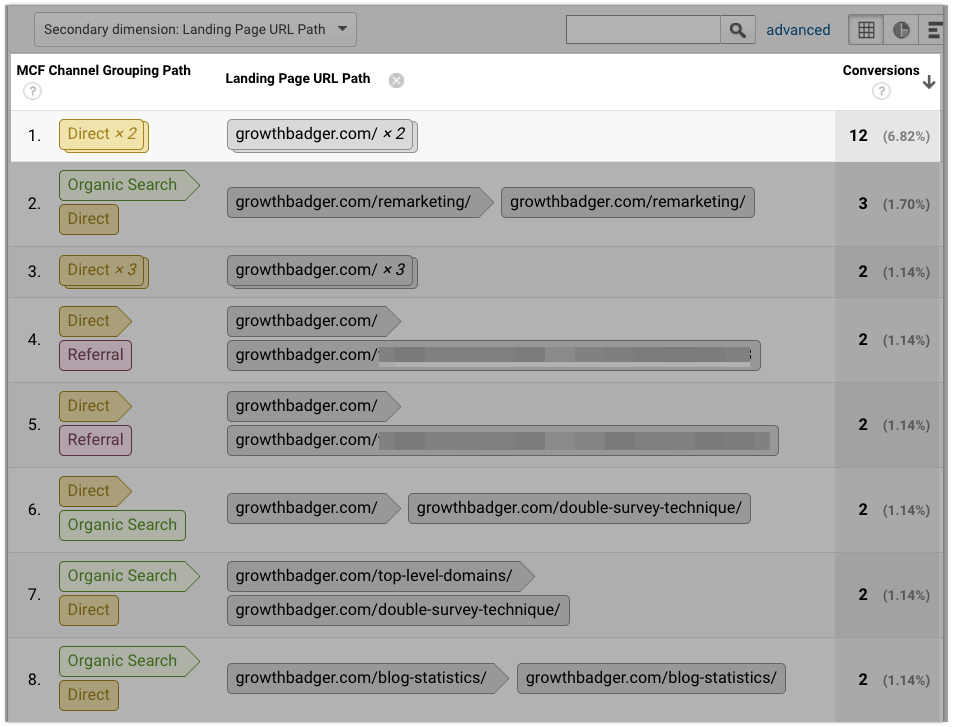
The next most common method is people coming to my ultimate remarketing guide via organic search, then coming back via direct. That article is extremely long, so it makes sense that people might be bookmarking it to revisit later.
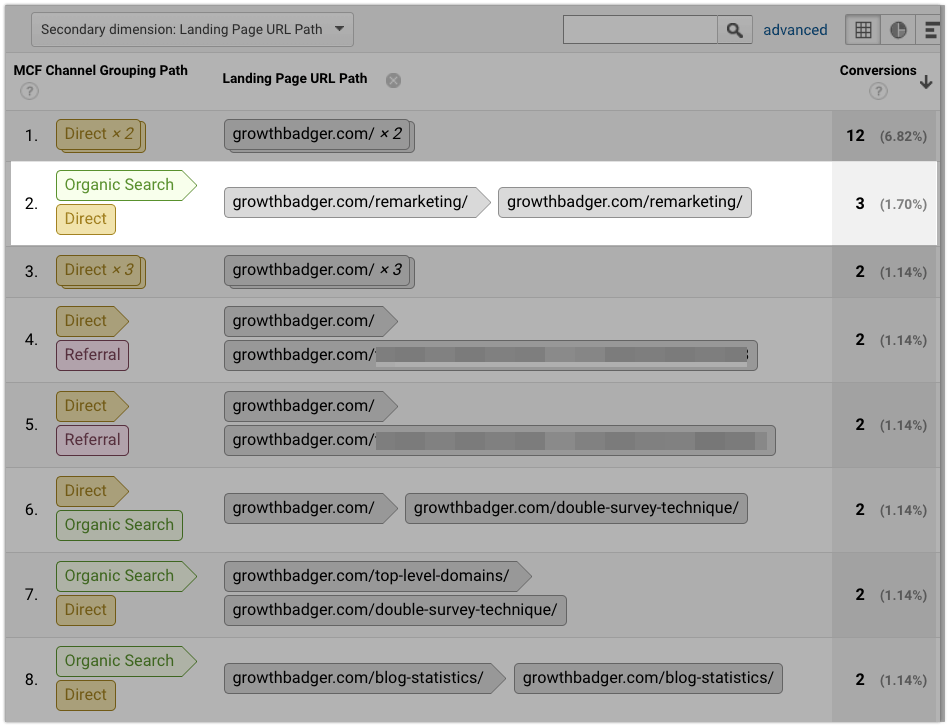
After that, there’s another instance of people coming directly to the homepage multiple times …
And a couple cases of people coming directly to the homepage, then following a link from someone else’s site (referral) to go to a second landing page URL I’ve been testing. (For data-integrity purposes I’ve blurred out the URL in the screenshot.)
If I wanted to see the exact source of that referral traffic, I could change the primary dimension to Source/Medium Path.
Things get more interesting again with #6 and #7.
With #6, you can see people coming directly to the homepage and then coming back via organic search to find my case study about the Double Survey Technique.
And #7 shows people finding my study about top-level domains via organic search, and then coming back directly to the Double Survey Technique post.
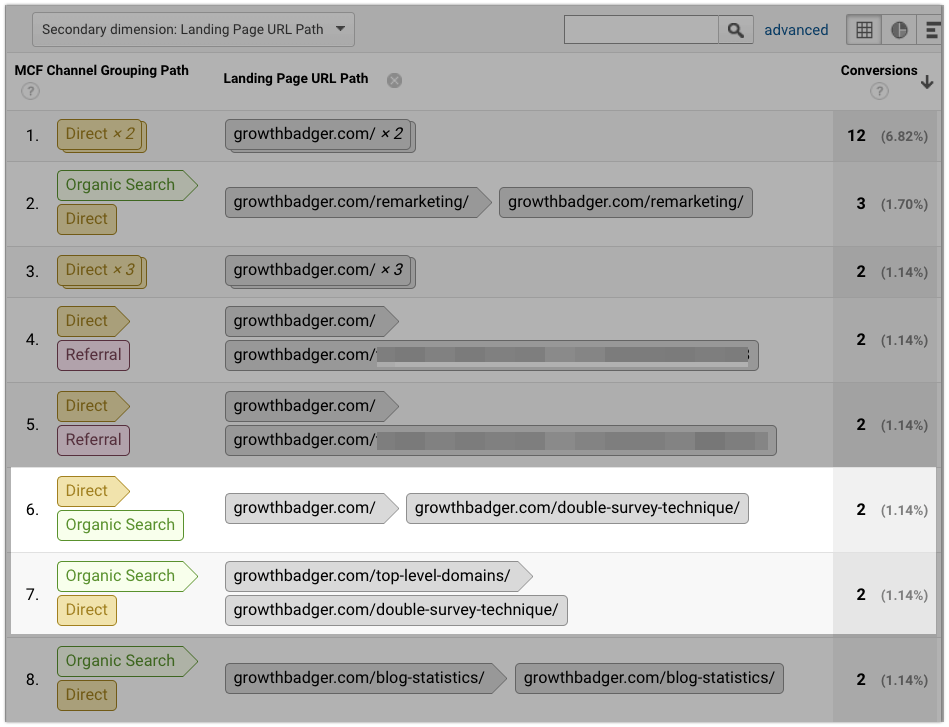
From this report, you can see how different pieces of content on this site reinforce each other to drive conversions.
But one thing I should point out are how small the numbers are in the screenshots above.
Most of the paths only had two conversions.
It would be better to have a lot more data to help separate random variation from meaningful patterns.
If you find yourself in this situation, the easiest way to get more data is by expanding the date range of the report.
Now that you know where your conversions are coming from, you can optimize your content marketing funnel to get more of them:
- Double-down on the types of content and traffic sources that are bringing in the most conversions.
- Share and link more to your top-performing pages.
- Test different angles for the pages that aren’t bringing results: change the headline or introduction, offer a different lead magnet, or double-check your research around the intent for that topic or keyword to ensure you’re approaching it the right way.
There’s always room for improvement if you let the data guide you.
It’s Your Turn
Now I’d love to know what you think.
Which technique from this guide are you going to try first?
Are you going to start by researching new keywords and topics? Or by using one of the reports I covered to see how your existing content performs?
Leave a comment below to let me know.

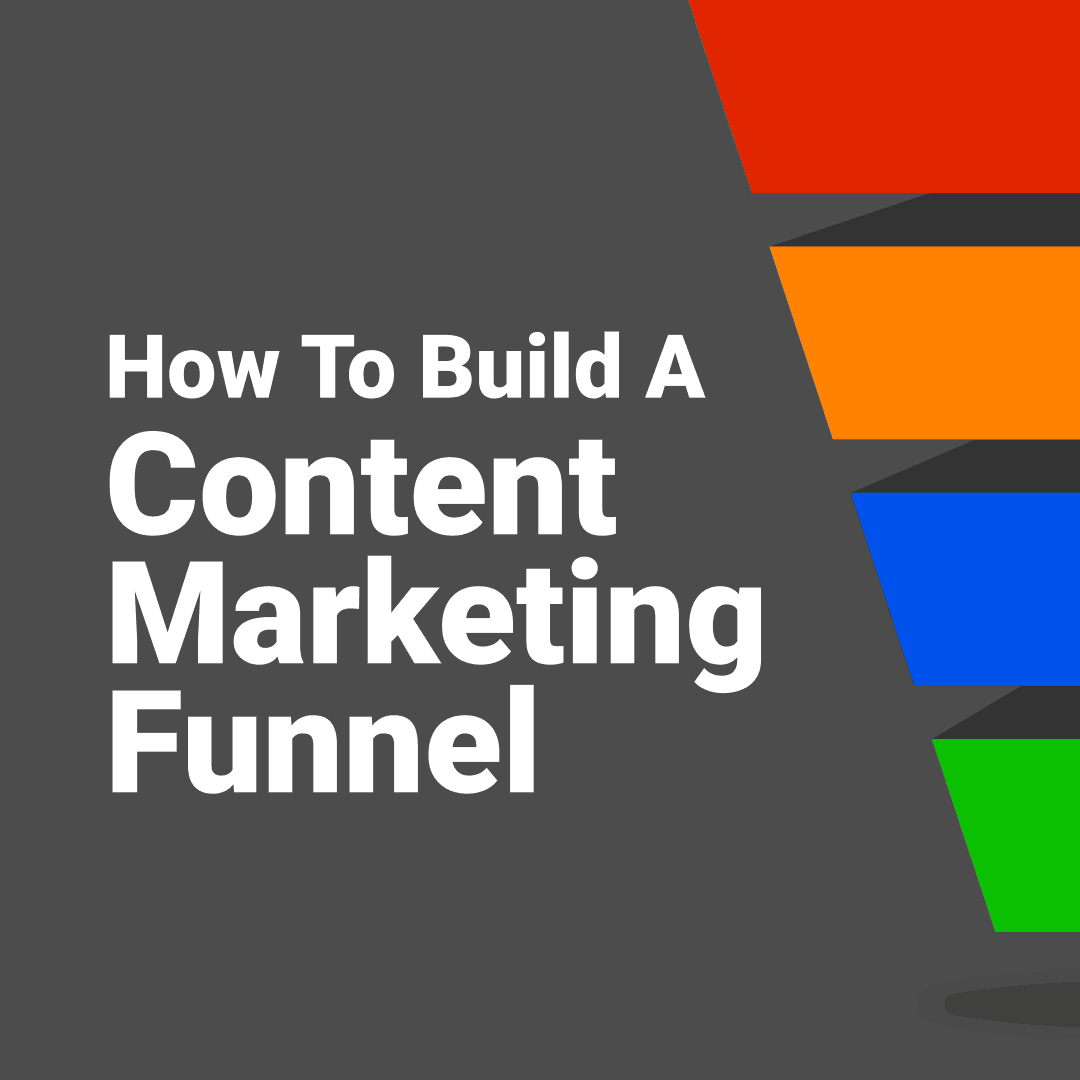
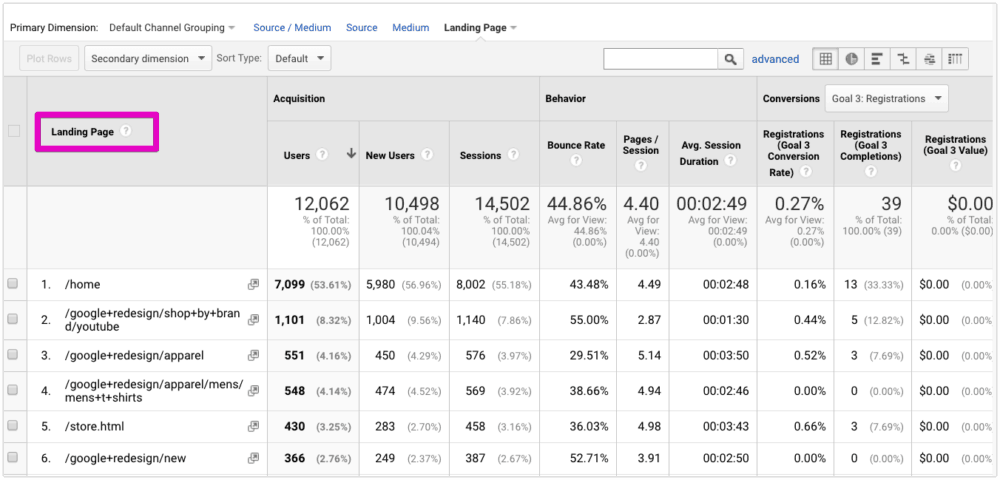
Awesome post, Kyle! Most of the posts that I’ve read about funnels are super high-level fluff pieces (“know your target customer’s needs” etc.). What I like about this post is that it’s actually STEPS that someone can follow to create their own high-converting funnel from scratch.